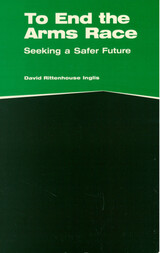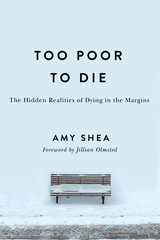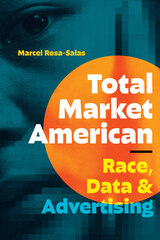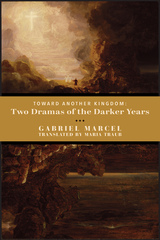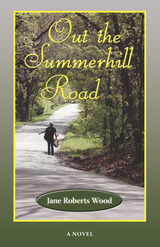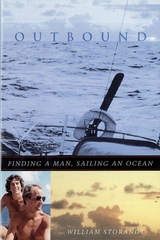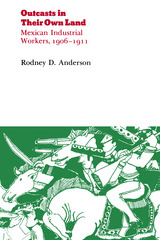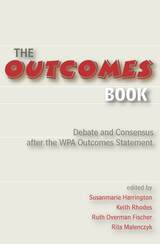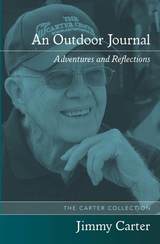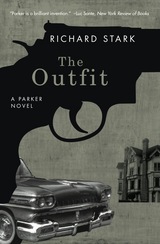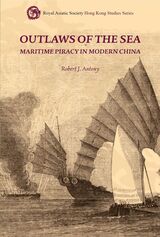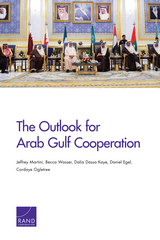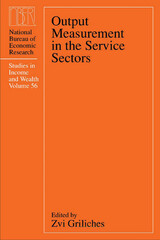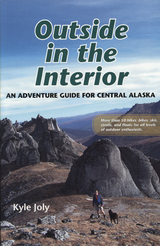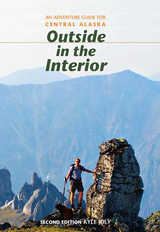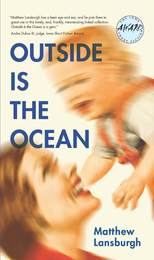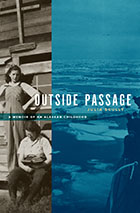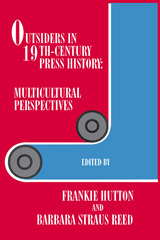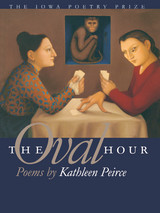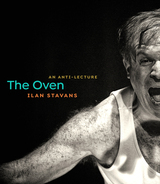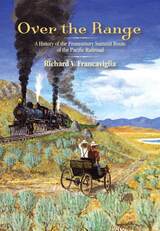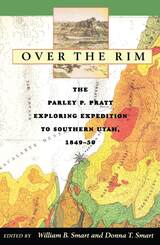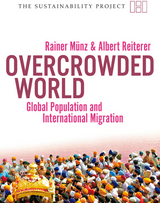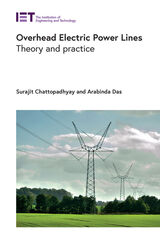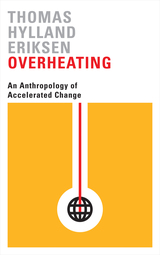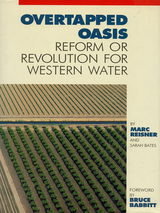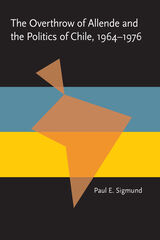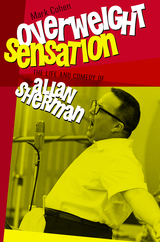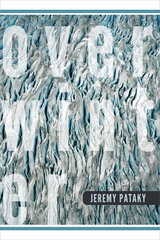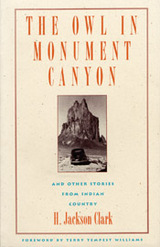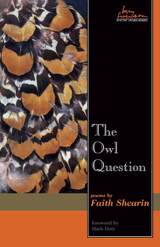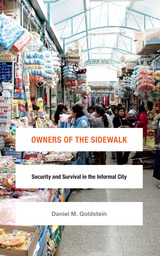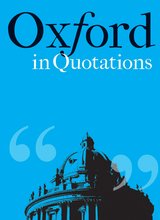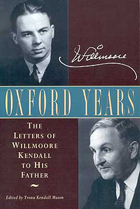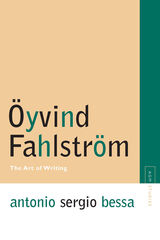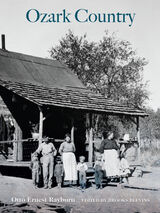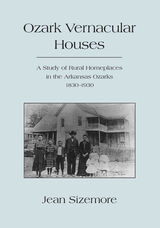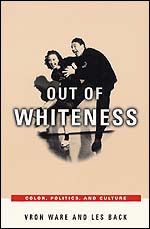 Out of Whiteness: Color, Politics, and Culture
Vron Ware and Les Back
University of Chicago Press, 2002 What happens when people in societies stratified by race refuse to accept the privileges inherent in whiteness? What difference does it make when whites act in a manner that contradicts their designated racial identity? Out of Whiteness considers these questions and argues passionately for an imaginative and radical politics against all forms of racism.
Vron Ware and Les Back look at key points in recent American and British culture where the "color line" has been blurred. Through probing accounts of racial masquerades in popular literature, the growth of the white power music scene on the Internet, the meteoric rise of big band jazz during the Second World War, and the pivotal role of white session players in crafting rhythm and blues classics by black artists, Ware and Back upset the idea of race as a symbol of inherent human attributes. Their book gives us a timely reckoning of the forces that continue to make people "white," and reveals to us the polyglot potential of identities and cultures.
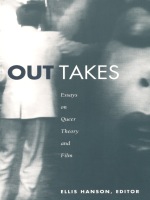 Out Takes: Essays on Queer Theory and Film
Ellis Hanson, ed.
Duke University Press, 1999 This collection brings together the work of both film scholars and queer theorists to advance a more sophisticated notion of queer film criticism. While the “politics of representation” has been the focus of much previous gay and lesbian film criticism, the contributors to Out Takes employ the approaches of queer theory to move beyond conventional readings and to reexamine aspects of the cinematic gaze in relation to queer desire and spectatorship. The essays examine a wide array of films, including Calamity Jane, Rear Window, The Hunger, Heavenly Creatures, and Bound , and discuss such figures as Doris Day, Elizabeth Taylor, and Alfred Hitchcock. Divided into three sections, the first part reconsiders the construction of masculinity and male homoerotic desire—especially with respect to the role of women—in classic cinema of the 1940s and 1950s. The second section offers a deconstructive consideration of lesbian film spectatorship and lesbian representation. Part three looks at the historical trajectory of independent queer cinema, including works by H.D., Kenneth Anger, and Derek Jarman. By exploring new approaches to the study of sexuality in film, Out Takes will be useful to scholars in gay and lesbian studies, queer theory, and cinema studies. Contributors. Bonnie Burns, Steven Cohan, Alexander Doty, Lee Edelman, Michelle Elleray, Jim Ellis, Ellis Hanson, D. A. Miller, Eric Savoy, Matthew Tinkcom, Amy Villarejo, Jean Walton
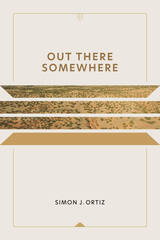 Out There Somewhere
Simon J. Ortiz
University of Arizona Press, 2002 He has been out there somewhere for a while now, a poet at large in America.
Simon Ortiz, one of our finest living poets, has been a witness, participant, and observer of interactions between the Euro-American cultural world and that of his Native American people for many years. In this collection of haunting new work, he confronts moments and instances of his personal past—and finds redemption in the wellspring of his culture.
A writer known for deeply personal poetry, Ortiz has produced perhaps his most personal work to date. In a collage of journal entries, free-verse poems, and renderings of poems in the Acoma language, he draws on life experiences over the past ten years—recalling time spent in academic conferences and writers' colonies, jails and detox centers—to convey something of the personal and cultural history of dislocation. As an American Indian artist living at times on the margins of mainstream culture, Ortiz has much to tell about the trials of alcoholism, poverty, displacement. But in the telling he affirms the strength of Native culture even under the most adverse conditions and confirms the sustaining power of Native beliefs and connections: "With our hands, we know the sacred earth. / With our spirits, we know the sacred sky."
Like many of his fellow Native Americans, Ortiz has been "out there somewhere"—Portland and San Francisco, Freiburg, Germany, and Martinique—away from his original homeland, culture, and community. Yet, as these works show, he continues to be absolutely connected socially and culturally to Native identity: "We insist that we as human cultural beings must always have this connection," he writes, "because it is the way we maintain a Native sense of existence." Drawing on this storehouse of places, times, and events, Out There Somewhere is a rich fusion taking readers into the heart and soul of one of today's most exciting and original American poets.
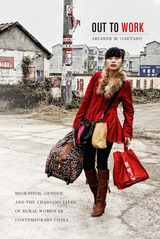 Out to Work: Migration, Gender, and the Changing Lives of Rural Women in Contemporary China
Arianne M. Gaetano
University of Hawaii Press, 2015 Out to Work is an engaging account of the lives of a group of rural Chinese women who, while still in their teens, moved from villages to Beijing to take up work as maids, office cleaners, hotel chambermaids, and schoolteachers. Among the vanguard of China’s great rural-urban migration in the 1990s, these women confronted challenges that were unique to their generation. They were deprived of an education because their families could not afford school fees for both sons and daughters, yet their plans to leave home and better their lives met with strong objections from parents who feared for their daughters’ safety and reputations in the big city. Lacking the local, urban household registration (hukou), they were channeled into inferior jobs and denied social welfare. This longitudinal and biographical exploration of migrant women’s lives demonstrates how the intersection of gendered norms and rural-urban inequalities shapes women’s identities and desires, and has deleterious material consequences. Yet, by pursuing new opportunities afforded by migration, and strategically applying accumulated knowledge and resources, these women forged better lives for themselves and their families. The book thus convincingly shows that migration for work increases rural women’s choices and possibilities for exercising agency, and advances gender equality. But it also makes clear that broader social inequalities persist to make these women’s futures precarious.
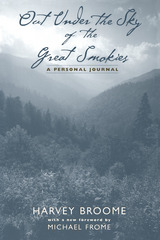 Out Under the Sky of the Great Smokies: A Personal Journal
Harvey Broome
University of Tennessee Press, 2001 “Harvey Broome was an early, indefatigable friend of the Great Smokies whose book combines an eloquent interpretation of the seasons of life they nurture with the urgent message that their conservation remains perpetually relevant. At once poetic and practical, Harvey Broome takes us into his Great Smokies and shows us that they are also ours, a unique treasure of endless discovery.”—Wilma Dykeman, Tennessee State Historian
“It is a seminal work and is ‘must reading’ for anyone seriously interested in the early interpretation of the Great Smoky Mountains.”—Arthur McDade, author of The Natural Arches of the Big South Fork
First published in a limited edition in 1975 by the author’s widow and now available in paperback for the first time, Out Under the Sky of the Great Smokies brings together the personal journals of a great environmentalist and nature writer.
The book combines descriptions of Broome’s innumerable hikes in the Great Smoky Mountains with extended meditations on the meaning of the mountains to the region as a whole. It is at once a historical document, preserving a perspective on the Smokies before full-scale development of the national park, and a work whose message about the importance of the environment is even more timely today than when it first appeared.
In a foreword written especially for this edition, the noted environmental writer Michael Frome describes the book as “a timeless work,” adding, “Here we find Harvey, the wilderness apostle on his home turf. He reveals himself exactly as I knew and loved him: a gentle spirit, sensitive to the needs of nature and humankind, always with tolerance and good humor.”
The Author: Harvey Broome (1902–1968) was born in Knoxville, Tennessee, and discovered the Great Smoky Mountain at an early age. An attorney, he helped found the Wilderness Society and served as president of the Smoky Mountains Hiking Club. He was the author of two other posthumously published books, Faces of the Wilderness and Harvey Broome: Earth Man.
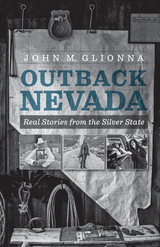 Outback Nevada: Real Stories from the Silver State
John M Glionna
University of Nevada Press, 2022 Join author John M. Glionna on a journey to discover the real Nevada, a place inhabited by diverse, spirited, and sometimes quirky people who make up the fabric of the Silver State. Outback Nevada explores the far-flung corners of the seventh-largest state in the nation and introduces its readers to the humanity, courage, strength, and charm of these little-known Americans. Each story is part of the vast collection of published articles Glionna has written during his decades of work as a journalist for the Los Angeles Times and the Las Vegas Review-Journal.
Glionna’s interest in Nevada’s rugged, isolated landscape and the people who choose to live in this often-harsh environment was born of his own wanderings into the “outback.” Through his stories, he shares intimate portraits of rural and small-town lifestyles not many understand. Readers meet men with names like Flash and Mr. Cool; will listen to a cowboy minister preach the word of God to his parishioners; will walk with an antiques dealer from Genoa as he hunts for denim in Nevada’s abandoned nineteenth-century mine shafts; and will learn from an ex-paramedic– turned–coffee-shop–owner who provides Boulder City with a true sense of community. Full of humor, eccentricities, and compassion, these stories reveal the state’s true nature and extend an invitation to get lost “somewhere out there” in the real Nevada.
Outback: Westerns in Australian Cinema
Brian McFarlane
Intellect Books, 2026 Studying the role of the Western film genre in Australia’s changing political and cultural landscape.
Focusing on the influence of the cinematic Western in Australian cinema history, Outback explores how the American genre has been adapted to the changing Australian social, political, and cultural contexts of its production, including the shifting emphases in the representation of the Indigenous population.
Brian McFarlane emphasizes the ways film can, without didacticism, provide evidence of changing politics and culture. McFarlane explores Australian history with the genre by analyzing such films as Charles Tait’s 1906 The Story of the Kelly Gang and Justin Kurzel’s 2020 adaptation of Peter Carey’s The True History of the Kelly Gang. He further explores other key matters, including the changing attitudes to and representation of Indigenous peoples and of women's roles in Australian Westerns.
Outbound: Finding a Man, Sailing an Ocean
William Storandt
University of Wisconsin Press, 2001 Outbound is the story of two voyages: an Atlantic crossing in the 33-foot cutter Clarity , bound for Scotland; and the hard voyage of self-discovery that finally brought Bill Storandt to his life partner. Storandt’s account of the adventure he had carefully planned with longtime partner Brian Forsyth and their friend Bob soon turns into a white-knuckled sailing tale, as they encounter a fierce storm four hundred miles from the Irish coast that tests their courage and all their sailing skills. The sea story, vividly evoking life in a small boat on a big ocean, is interwoven with Storandt’s flashbacks to his earlier life. Outbound delivers its share of excitement, but it’s also a moving reflection on how circuitous our paths can be, even when the destination is clear and beckoning.
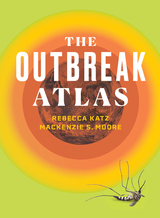 The Outbreak Atlas
Rebecca Katz and Mackenzi S. Moore
Vanderbilt University Press, 2024 The public has taken a new level of interest in outbreak response since 2020, learning epidemiological terms and seeking information about how to stay prepared in a pandemic. Public health professionals are calling on citizen scientists’ participation as outbreaks are increasingly occurring in complex environments, expanding the number of people and types of activities required to control the spread of disease. However, there is no comprehensive source mapping this complexity and detailing needed actions tailored to the public.
For years the Georgetown University Center for Global Health Science and Security has curated an interactive online tool for professionals that identifies the activities involved across all phases of an outbreak. The Georgetown Outbreak Activity Library (GOAL) captures what needs to get done, when, and by whom. Now, in The Outbreak Atlas, Rebecca Katz and Mackenzie S. Moore have translated this complex material into a book designed for a public audience.
This book provides an overview of outbreak activities alongside compelling case studies and visuals to guide readers through the complexity involved in outbreak preparedness, response, and recovery. It lifts the curtain on the rationale and interconnectedness of outbreak responses across different fields and at various levels, presenting accessible information that ensures a shared understanding of the essential activities to control an outbreak.
 Outbreak Culture: The Ebola Crisis and the Next Epidemic
Pardis Sabeti and Lara Salahi
Harvard University Press, 2018 An award-winning genetic researcher who helped contain the Ebola outbreak and a prize-winning journalist reveal what it will take to prevent the next pandemic from spiraling out of control.
As we saw with our response to Ebola and Zika—and are seeing now with the disastrous early handling of the coronavirus COVID-19 outbreak—a lack of preparedness, delays in action, and large-scale system-wide problems with the distribution of critical medical resources can result in lost lives.
Outbreak Culture examines each phase of the 2014 Ebola outbreak in West Africa—one of the largest and deadliest epidemics to date—and identifies factors that prevented key information from reaching physicians. Drawing insights from clinical workers, data collectors, organizational experts, and public health researchers, Pardis Sabeti and Lara Salahi expose a fractured system that failed to gather and share knowledge of the virus and ensure timely containment. The authors describe how much more could have been done by global medical and political organizations to safeguard the well-being of caregivers, patients, and communities affected by this devastating outbreak and they outline changes that are urgently needed to ensure a more effective coordinated response to the next epidemic.
Secrecy, competition, and poor coordination plague nearly every major public health crisis—and we are seeing their deadly consequences play out again. A work of fearless integrity and unassailable authority, Outbreak Culture seeks to change the culture of responders.
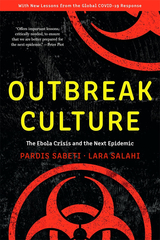 Outbreak Culture: The Ebola Crisis and the Next Epidemic, With a New Preface and Epilogue
Pardis Sabeti and Lara Salahi
Harvard University Press, 2021 A Choice Outstanding Academic Title of the Year
“A critical, poignant postmortem of the epidemic.”
—Washington Post
“Forceful and instructive…Sabeti and Salahi uncover competition, sabotage, fear, blame, and disorganization bordering on chaos, features that are seen in just about any lethal epidemic.”
—Paul Farmer, cofounder of Partners in Health
“The central theme of the book…is that common threads of dysfunction run through responses to epidemics…The power of Outbreak Culture is its universality.”
—Nature
“Sabeti and Salahi present a wealth of evidence supporting the imperative that outbreak response must operate in a coordinated, real-time manner.”
—Science
As we saw with the Ebola outbreak—and the disastrous early handling of the COVID-19 coronavirus pandemic—a lack of preparedness, delays, and system-wide problems with the distribution of critical medical supplies can have deadly consequences. Yet after every outbreak, the systems put in place to coordinate emergency responses are generally dismantled.
One of America’s top biomedical researchers, Dr. Pardis Sabeti, and her Pulitzer Prize–winning collaborator, Lara Salahi, argue that these problems are built into the ecosystem of our emergency responses. With an understanding of the path of disease and insight into political psychology, they show how secrecy, competition, and poor coordination plague nearly every major public health crisis and reveal how much more could be done to safeguard the well-being of caregivers, patients, and vulnerable communities. A work of fearless integrity and unassailable authority, Outbreak Culture seeks to ensure that we make some urgently needed changes before the next pandemic.
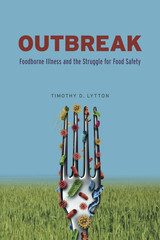 Outbreak: Foodborne Illness and the Struggle for Food Safety
Timothy D. Lytton
University of Chicago Press, 2019 Foodborne illness is a big problem. Wash those chicken breasts, and you’re likely to spread Salmonella to your countertops, kitchen towels, and other foods nearby. Even salad greens can become biohazards when toxic strains of E. coli inhabit the water used to irrigate crops. All told, contaminated food causes 48 million illnesses, 128,000 hospitalizations, and 3,000 deaths each year in the United States.
With Outbreak, Timothy D. Lytton provides an up-to-date history and analysis of the US food safety system. He pays particular attention to important but frequently overlooked elements of the system, including private audits and liability insurance.
Lytton chronicles efforts dating back to the 1800s to combat widespread contamination by pathogens such as E. coli and salmonella that have become frighteningly familiar to consumers. Over time, deadly foodborne illness outbreaks caused by infected milk, poison hamburgers, and tainted spinach have spurred steady scientific and technological advances in food safety. Nevertheless, problems persist. Inadequate agency budgets restrict the reach of government regulation. Pressure from consumers to keep prices down constrains industry investments in safety. The limits of scientific knowledge leave experts unable to assess policies’ effectiveness and whether measures designed to reduce contamination have actually improved public health. Outbreak offers practical reforms that will strengthen the food safety system’s capacity to learn from its mistakes and identify cost-effective food safety efforts capable of producing measurable public health benefits.
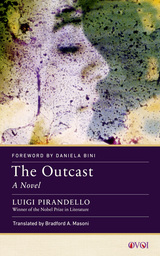 The Outcast: A Novel
Luigi Pirandello
Rutgers University Press, 2023 A young wife in a nineteenth-century Sicilian village, Marta is deeply in love with her husband Rocco and pregnant with his child. But when Rocco discovers a letter written to Marta by a would-be suitor, he falsely accuses her of infidelity and banishes her from their home. Soon the whole village turns against the supposed adulteress, setting in motion a series of tragic events that culminates in the loss of Marta’s family home and business, as well as the deaths of her father and newborn child. Plunged into poverty and treated as a social leper, with practically nothing else to lose, Marta is determined to claw her way back into a society bent on excluding her.
The Outcast is an early masterwork from Nobel Prize–winning Italian author Luigi Pirandello that combines elements of Zolaesque naturalism with emerging modernist aesthetics. This fresh English translation, the first in nearly one hundred years, showcases Pirandello’s deft play with language and his use of irony.
This book was translated thanks to a grant awarded by the Italian Ministry of Foreign Affairs and International Cooperation.
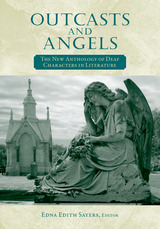 Outcasts and Angels: The New Anthology of Deaf Characters in Literature
Edna Edith Sayers
Gallaudet University Press, 2012 In 1976, Trent Batson and Eugene Bergman released their classic Angels and Outcasts: An Anthology of Deaf Characters in Literature. In it, they featured works from the 19th and 20th centuries by well-known authors such as Charles Dickens and Eudora Welty. They also presented less-well-known deaf authors, and they prefaced each excerpt with remarks on context, societal perceptions, and the dignity due to deaf people. Since then, much has transpired, turning around the literary criticism regarding portrayals of deaf people in print. Edna Edith Sayers reflects these changes in her new collection Outcasts and Angels: The New Anthology of Deaf Characters in Literature.
Sayers mines the same literary vein as the first volume with rich new results. Her anthology also introduces rare works by early masters such as Daniel Defoe. She includes three new deaf authors, Charlotte Elizabeth, Howard T. Hofsteater, and Douglas Bullard, who offer compelling evidence of the attitudes toward deaf people current in their eras. In search of commonalities and comparisons, Sayers reveals that the defining elements of deaf literary characters are fluid and subtly different beyond the predominant dueling stereotypes of preternaturally spiritual beings and thuggish troglodytes.
Outcasts and Angels demonstrates these subtle variations in writings by Ambrose Bierce, Isak Dinesen, Nadine Gordimer, and Flannery O’Connor. Stories by Juozas Grušas, Julian Barnes, and many other international authors broaden the scope of this updated inquiry into the deaf literary character. Sayer’s preface and closing essay bring any disparate parts together, completing Outcasts and Angels as a fitting, contemporary companion to the original classic collection.
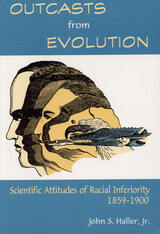 Outcasts from Evolution: Scientific Attitudes of Racial Inferiority, 1859 - 1900
John S. Haller, Jr.
Southern Illinois University Press, 1996 In the only book to date to explore the period between the 1859 publication of Darwin’s Origin of Species and the discovery in 1900 of Gregor Mendel’s experiments in genetics, John S. Haller, Jr., shows the relationship between scientific "conviction" and public policy. He focuses on the numerous liberally educated American scientists who were caught up in the triumph of evolutionary ideas and who sought to apply those ideas to comparative morality, health, and the physiognomy of nonwhite races. During this period, the natural and social scientists of the day not only accepted without question the genetic and cultural superiority of the Caucasian; they also asserted that the Caucasian race held a monopoly on evolutionary progress, arguing that "inferior races" were no more than evolutionary survivors doomed by their genetic legacy to remain outcasts from evolution. Hereditarians and evolutionists believed that "less fit" human races were perishing from the rigors of civilization’s struggle and competition. Indeed, racial inferiority lay at the very foundation of the evolutionary framework and, remaining there, rose to the pinnacle of "truth" with the myth of scientific certainty.
Outcomes Book: Debate and Consensus after the WPA Outcomes Statement
edited by Susanmarie Harrington, Keith Rhodes, Ruth Fischer, & Rita Malenczyk
Utah State University Press, 2005 The WPA Outcomes Statement is important because it represents a working consensus among composition scholars about what college students should learn and do in a composition program. But as a single-page document, the statement cannot convey the kind of reflective process that a writing program must undertake to address the learning outcomes described. The Outcomes Book relates the fuller process by exploring the matrix of concerns that surrounded the developing Statement itself, and by presenting the experience of many who have since employed it in their own settings.
 The Outcomes of Counseling and Psychotherapy: Theory and Research
Theodore Volsky, Jr.
University of Minnesota Press, 1965
The Outcomes of Counseling and Psychotherapy was first published in 1965. Minnesota Archive Editions uses digital technology to make long-unavailable books once again accessible, and are published unaltered from the original University of Minnesota Press editions.
How is the future behavior of a client or patient affected by counseling, casework, or psychotherapy? What fundamental personality changes, if any, can be attributed to such treatment? What does the counselor do that determines the outcome of his efforts? This volume deals with questions like these, questions which concern not only psychologists, psychiatrists, social workers, and other counselors, but also the communities, institutions, and agencies which support their work.
The report presented here is based on the findings of a ten-year project conducted at the University of Minnesota Student Counseling Bureau to assess the results of its counseling program. Since the early days of counseling at Minnesota, many studies, in a research program extending over a period of thirty years, have attempted to determine the effectiveness of counseling. In continuing these studies, the present authors have applied current statistical methods to contemporary counseling theory and practices. This account of the search for specific variables that define the goals of counseling, and for instruments to measure those variables objectively, is an important contribution to future research in the field. Ralph F. Berdie, director of the University of Minnesota Student Counseling Bureau, writes a foreword.
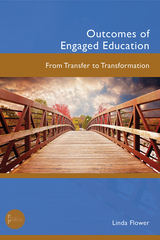 Outcomes of Engaged Education: From Transfer to Transformation
Linda Flower
University Press of Colorado, 2025 Revealing the impressive unseen outcomes community engaged and intellectually challenging classes can have for college students, Outcomes of Engaged Education combines case studies with introductions to informal methods for tracking how students transfer, transform, and apply such learning to their lives as well as how to engage them in this collaborative inquiry. Drawing on 20 years of data to document the significant outcomes such experiences have had for college students in their lives—up to ten years later—Linda Flower reveals a critical distinction between transfer and the transformation of knowledge. Each chapter embeds its methods in a set of case studies modeling the methods and reflecting on the findings emerging from its use. The result is a book that considers how we as teachers can draw our students into this inquiry and help them develop a more articulate awareness of their experiential knowledge, choices, and agency.
Outcomes of General Education: An Appraisal of the General College Program
Ruth E. Eckert
University of Minnesota Press, 1943
Outcomes of General Education was first published in 1943. Minnesota Archive Editions uses digital technology to make long-unavailable books once again accessible, and are published unaltered from the original University of Minnesota Press editions.
An Outdoor Journal: Adventures and Reflections
Jimmy Carter
University of Arkansas Press, 1994 An Outdoor Journal, first published in 1988, is President Carter’s memoir of hunting and fishing and the meaning of nature, revealing much about a man who embodies “so much of what Americans claim to admire—self-reliance, honesty, humor, modesty, intelligence—the stuff of heroes” (The New York Times Book Review).
 The Outer Bands
Gabriel Gomez
University of Notre Dame Press, 2007
The Outer Bands is a first collection of poems from Andrés Montoya prize-winner Gabriel Gomez. The book is an expansive examination of language and landscape, voice and memory, where the balance between experimentation and tradition coexist. The poems realize a reconciliation between the writer’s voice and the voice of witness, wonder, and tragedy; a dialogue between two worlds that employ an equally paradoxical imagery of the American Southwest and the marshes of Southern Louisiana. The book concludes with its namesake poem, “The Outer Bands,” a twenty-eight-day chronicle of the days between Hurricane Katrina and Hurricane Rita, which together decimated the Gulf Coast region in 2005. The sequence poem, a pastiche and re-contextualization of images, news blurbs, and political rhetoric, travels and responds in a spare subjectivity to the storm. Gabriel Gomez completed it during a two-month emergency residency at the Santa Fe Art Institute after his home in New Orleans was destroyed.
"Gabriel Gomez has a perceptive eye and a cunning ear, bands of cellos and bands of starlings. And then The Outer Bands, where none of us is untouched or unmoved by the hurricane of devastation, this new century, so replete with human failures. For Gomez the longing of retablos, the aching after faith, is balanced with clarity and knowing. His poetry is a kindness in the midst of a disordered world; a spire rising from the floodwaters.What a remarkable gift to us all." —D. A. Powell
“Gabriel Gomez is an accomplished poet, one who honors the resonance of language as well as reverberations of form. And, like a retablo, each poem shimmers with reverence, if not for saints and Biblical figures, but for the beauty and poignancy of complex, contemporary life.” —Valerie Martinez, from the introduction
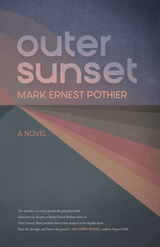 Outer Sunset
Mark Ernest Pothier
University of Iowa Press, 2023 Jim Finley—a recently retired English teacher living alone on the shifting edge of San Francisco—has been set, unwittingly, on the back porch of life. Trying to harmonize the voices in his head, he sits most days by his stack of “to-do” books until, one day, his daughter comes home with the worst news of her life. Everything changes. As his broken heart reengages, he steps back into a new world. He sees his ex-wife has launched into a larger life than the one they’d shared. He is surprised to find it easier to talk to his son’s immigrant girlfriend, or even the remains of a Russian saint, than to the young man he’s raised. He misconnects with Carol—his first date in decades—a woman he enjoys talking with but doesn’t quite hear. Set in the pre-tech calm before the turn of this century, Outer Sunset is a deeply felt story about the intimate place where long-lasting growth occurs in our lives; how we revise, or live without, our dreams; how to love the flaws of those closest to you and watch a child grow away into someone better than you’d imagined; and how to be shaken by beauty amidst unimaginable loss and remain standing.
The Outfit: A Parker Novel
Richard Stark
University of Chicago Press, 1963 They wanted Parker dead—and a late-night visit from a hitman proved they meant business. Now Parker plans to get even—dead even. Armed with a new face and his usual iron will, Parker is declaring a coast-to-coast war.
In The Outfit, Parker goes toe-to-toe with the mob, hellbent on taking him down. The notorious lone wolf has some extra tricks up his sleeve, and the entire underworld will learn an unforgettable lesson: whatever Parker does, he does deadly.
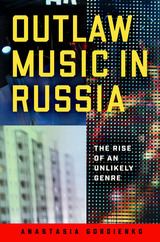 Outlaw Music in Russia: The Rise of an Unlikely Genre
Anastasia Gordienko
University of Wisconsin Press, 2023 The Russian shanson can be heard across the country today, on radio and television shows, at mass events like political rallies, and even at the Kremlin. Yet despite its ubiquity, it has attracted almost no scholarly attention. Anastasia Gordienko provides the first full history of the shanson, from its tenuous ties to early modern criminals’ and robbers’ folk songs, through its immediate generic predecessors in the Soviet Union, to its current incarnation as the soundtrack for daily life in Russia. It is difficult to firmly define the shanson or its family of song genres, but they all have some connection, whether explicit or implicit, to the criminal underworld or to groups or activities otherwise considered subversive. Traditionally produced by and popular among criminals and other marginalized groups, and often marked by characters and themes valorizing illegal activities, the songs have undergone censorship since the early nineteenth century. Technically legal only since the collapse of the Soviet Union, the shanson is today not only broadly popular but also legitimized by Vladimir Putin’s open endorsement of the genre. With careful research and incisive analysis, Gordienko deftly details the shanson’s history, development, and social meanings. Attempts by imperial rulers, and later by Soviet leaders, to repress the songs and the lifestyles they romanticized not only did little to discourage their popularity but occasionally helped the genre flourish. Criminals and liberal intelligentsia mingled in the Gulag system, for instance, and this contact introduced censored songs to an educated, disaffected populace that inscribed its own interpretations and became a major point of wider dissemination after the Gulag camps were closed. Gordienko also investigates the shanson as it exists in popular culture today: not divorced from its criminal undertones (or overtones) but celebrated for them. She argues that the shanson expresses fundamental themes of Russian culture, allowing for the articulation of anxieties, hopes, and dissatisfactions that are discouraged or explicitly forbidden otherwise.
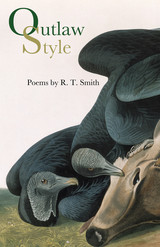 Outlaw Style: Poems
R. T. Smith
University of Arkansas Press, 2007 Outlaw Style is a collection of narrative and lyric poems, many of them in the tradition of Robert Browning’s dramatic monologues. While gothic imagery, humor, and nineteenth-century diction and reference alternate and interweave, the four thematic currents that converge in the collection are music, race, spirituality, and the impact of monstrosity on somewhat innocent bystanders. Poems like “Dar He,” “Scuppernongs,” and “Plantation of the Mad” address the history of American racial intolerance with muted horror, while the final series of poems explores the roots and impact of traditional music, from unsettling songs of the Carter Family through Delta Blues and the haunting ballad “Strange Fruit.” The collection also features poems, such as “Shepherd Ollie Strawbridge on the Chicken Business,” which question the nature of spirituality; and the central section, “The Booth Prism,” performs a kind of séance in which the author channels the voices of many of the people—from Anna Surratt Tonry to Booth’s lovers and siblings—whose lives were altered by contact with Lincoln’s assassin. Throughout Outlaw Style formal and vernacular rhythms stand in counterpoint, images of violence excavate a stark and troubling beauty, and history and mystery fuse and feud, as the landscape and culture of the American South are presented for interrogation and understanding.
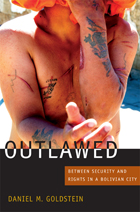 Outlawed: Between Security and Rights in a Bolivian City
Daniel M. Goldstein
Duke University Press, 2012 In Outlawed, Daniel M. Goldstein reveals how indigenous residents of marginal neighborhoods in Cochabamba, Bolivia, struggle to balance security with rights. Feeling abandoned to the crime and violence that grip their communities, they sometimes turn to vigilante practices, including lynching, to apprehend and punish suspected criminals. Goldstein describes those in this precarious position as "outlawed": not protected from crime by the law but forced to comply with legal measures in other areas of their lives, their solutions to protection criminalized while their needs for security are ignored. He chronicles the complications of the government's attempts to provide greater rights to indigenous peoples, including a new constitution that recognizes "community justice." He also examines how state definitions of indigeneity ignore the existence of marginal neighborhoods, continuing long-standing exclusionary practices. The insecurity felt by the impoverished residents of Cochabamba—and, more broadly, by the urban poor throughout Bolivia and Latin America—remains. Outlawed illuminates the complex interconnections between differing definitions of security and human rights at the local, national, and global levels.
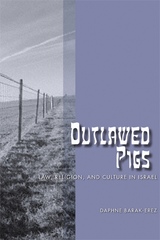 Outlawed Pigs: Law, Religion, and Culture in Israel
Daphne Barak-Erez
University of Wisconsin Press, 2007 The prohibition against pigs is one of the most powerful symbols of Jewish culture and collective memory. Outlawed Pigs explores how the historical sensitivity of Jews to the pig prohibition was incorporated into Israeli law and culture.
Daphne Barak-Erez specifically traces the course of two laws, one that authorized municipalities to ban the possession and trading in pork within their jurisdiction and another law that forbids pig breeding throughout Israel, except for areas populated mainly by Christians. Her analysis offers a comprehensive, decade-by-decade discussion of the overall relationship between law and culture since the inception of the Israeli nation-state.
By examining ever-fluctuating Israeli popular opinion on Israel's two laws outlawing the trade and possession of pigs, Barak-Erez finds an interesting and accessible way to explore the complex interplay of law, religion, and culture in modern Israel, and more specifically a microcosm for the larger question of which lies more at the foundation of Israeli state law: religion or cultural tradition.
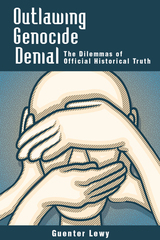 Outlawing Genocide Denial: The Dilemmas of Official Historical Truth
Guenter Lewy
University of Utah Press, 2014 Historian and political scientist Guenter Lewy is no stranger to the topic of genocide nor to exploring controversial issues. His penchant for approaching topics from contentious angles continues in Outlawing Genocide Denial, as he scrutinizes the practice of criminalizing genocide denial.
Holocaust denial can be viewed as another form of hatred against the Jews and preventing it can be understood as a form of warding off hate speech. Germany has made it a crime punishable by law. Other European countries have similar laws. While the rationale for such laws seems reasonable, Lewy asks readers to look again and to consider carefully the dangers that these laws could present. His discussion neither dismisses the ramifications of genocide denial nor justifies it; he instead looks closely at the possible risks of government-enforced interpretations of history.
Outlawing genocide denial sets a precedent of allowing governments to dictate historical truth and how events should be interpreted. Such government restrictions can be counterproductive in a democratic society which values freedom of speech. Lewy examines these and related ideas through the analysis of historical and current examples. He posits his own conclusion but leaves it up to readers to view the evidence and arguments and form their own opinions.
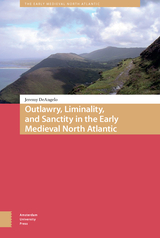 Outlawry, Liminality, and Sanctity in the Literature of the Early Medieval North Atlantic
Jeremy DeAngelo
Amsterdam University Press, 2019 In reality, medieval outlaws were dangerous, desperate individuals. In the fiction of the Middle Ages, however, the possibilities afforded by their position on societies’ margins granted them the ability to fill a number of transitory, transgressive roles: young adventurer, freedom fighter, and even saint. Outlawry, Liminality, and Sanctity in the Literature of the Early Medieval North Atlantic examines the development of the literary outlaw in the early Middle Ages, when traditions drawn from Anglo-Saxon England, early Christian Ireland, and Viking Age Iceland informed a generous view of itinerant criminality and facilitated the application of outlaw tropes to moral questions of conduct in both secular and religious life. Taken together, the traditions of the North Atlantic archipelago reveal a world of interconnected cultures with an expansive view of movement across boundaries both literal and conceptual, capable of finding value in unlikely places and countenancing the challenges presented by such discoveries.
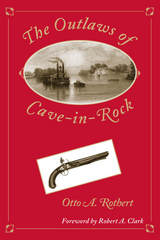 The Outlaws of Cave-in-Rock
Otto A. Rothert. Foreword by Robert Clark
Southern Illinois University Press, 1996 Exceptionally rare and valued by book collectors, Otto A. Rothert’s riveting saga of the outlaws and scoundrels of Cave-in-Rock chronicles the adventures of an audacious cast of river pirates and highwaymen who operated in and around the famous Ohio River cavern from 1795 through 1820 (adventures featured in Disney’s Davy Crockett and the film How the West Was Won). Once sporting the enticing sign "Liquor Vault and House for Entertainment," this beautiful cavern location decoyed the unsuspecting by offering a venue for food, drink, and rest. Compellingly lively, The Outlaws of Cave-in-Rock is nonetheless the work of a scholar, a historian who documents his findings and leaves a detailed bibliographical trail. Presenting many eyewitness accounts, Rothert supplies the lore and legend of the colorful villains of Cave-in-Rock. Always maintaining the difference between stories he tells with historical authority and those that are pure speculation, Rothert provides both a fascinating narrative and a valuable regional history.
Outlaws of the Sea: Maritime Piracy in Modern China
Robert J. Antony
Hong Kong University Press, 2024 A compelling study of piracy in modern South China.
In Outlaws of the Sea, Robert J. Antony provides a comprehensive account of the history of maritime piracy in coastal south China from the 1630s to the 1940s. He neither romanticizes nor maligns pirates, but rather analyzes them in the context of their times and the broader world in which they lived. The author demonstrates that Chinese piracy was a pervasive force shaping maritime society as it ebbed and flowed between sporadic, small-scale ventures and professional, large-scale enterprises in the modern era. This book offers important new insights into the underside of modern China’s history and the interactions between pirates, foreign traders, local communities, and the state.
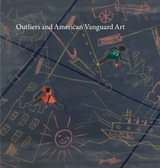 Outliers and American Vanguard Art
Lynne Cooke
University of Chicago Press, 2017 Since the last century, the relationship between vanguard and self-taught artists has been defined by contradiction. The established art world has been quick to make clear distinctions between trained and untrained artists, yet at the same time it has been fascinated by outliers whom it draws selectively and intermittently into its orbits. For a new exhibition launching at the National Gallery of Art, curator Lynne Cooke explores shifting conceptualizations of the American outlier across the twentieth century, drawing on the inherent sociality of the exhibition in her installation of these works. This companion catalog, Outliers and American Vanguard Art, offers a fantastic opportunity to consider works by schooled and self-taught creators in relation to each other and defined by historical circumstance.
The art works in Outliers and American Vanguard Art come from three distinct periods when the intersections between mainstream and outlier artists were most dynamic and productive, ushering in exhibitions of art based on various degrees of co-existence, inclusion, and assimilation. Works by such diverse artists as Charles Sheeler, Christina Ramberg, and Matt Mullican are set in conversation with a range of works by such self-taught artists as Horace Pippin, Janet Sobel, and Henry Darger. Cooke also examines a recent increase of radically expressive work that challenges what it means to be an outlier today. She reveals how these distinctions have been freighted with a particularly American point of view as she investigates our assumptions about creativity, artistic practice, and the role of the artist in contemporary culture.
Outliers and American Vanguard Art is the most comprehensive show ever to examine outliers in dialogue with their established peers. It is sure to inspire vigorous conversation about how artists and the work they make are represented.
 An Outline of the Origins of Money
Heinrich Schurtz
HAU, 2024 A new English translation of a forgotten German text that influenced cultural understanding of money in the early twentieth century.
“On this subject, I only knew the excellent little book by the late Schurtz”—Marcel Mauss, 1914, Les origines de la notion de monnaie.
Heinrich Schurtz’s 1898 book has been a touchstone for economic historians, anthropologists, and philosophers interested in the nature and origins of money in various societies, including Georg Simmel, Max Weber, Marcel Mauss, and Karl Polanyi. In his brief book, Schurtz experimented with concepts about money, going beyond traditional economic paradigms. Drawing on an extensive range of archaeological and ethnographic sources, he reframed a theory of money to include its materiality, symbolic nature, relationship to forms of property, and its dual origin in “outside money” and “inside money.” While it is not well known today, it was important to the theorization of money in the first half of the 20th century and its innovative synthesis offers galvanizing questions and insights into how value relations are formed and how currency systems are interrelated.
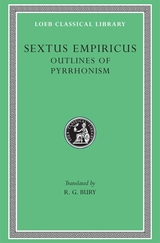 Outlines of Pyrrhonism
Sextus Empiricus
Harvard University Press A suspicious mind.
Sextus Empiricus (ca. AD 160–210), exponent of scepticism and critic of the Dogmatists, was a Greek physician and philosopher, pupil and successor of the medical sceptic Herodotus (not the historian) of Tarsus. He probably lived for years in Rome and possibly also in Alexandria and Athens. His three surviving works are Outlines of Pyrrhonism (three books on the practical and ethical scepticism of Pyrrho of Elis, ca. 360–275 BC, as developed later, presenting also a case against the Dogmatists); Against the Dogmatists (five books dealing with the Logicians, the Physicists, and the Ethicists); and Against the Professors (six books: Grammarians, Rhetors, Geometers, Arithmeticians, Astrologers, and Musicians). These two latter works might be called a general criticism of professors of all arts and sciences. Sextus’ work is a valuable source for the history of thought especially because of his development and formulation of former sceptic doctrines.
The Loeb Classical Library edition of Sextus Empiricus is in four volumes.
The Outlook for Arab Gulf Cooperation
Jeffrey Martini
RAND Corporation, 2016 This report examines what binds and divides the six Gulf Cooperation Council (GCC) states—Bahrain, Kuwait, Oman, Qatar, Saudi Arabia, and the United Arab Emirates—and presents the outlook for the GCC’s evolution over the next ten years. The study aims to help policymakers better understand intra-GCC dynamics and prepare for future trends in a region with high stakes for U.S. strategic interests.
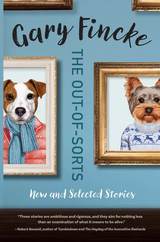 The Out-of-Sorts: New and Selected Stories
Gary Fincke
West Virginia University Press, 2017 The new and selected stories in this collection, written over a period of thirty years, are firmly entrenched in the culture and people of rust belt cities and rural Appalachia.
These stories are often set against large, significant events like the Cold War, Vietnam, and the Kent State shootings, but are always uniquely local. A mother fends off the police by brandishing copperhead snakes. A woman cares for the dog of an alleged double murderer. A husband who has lost his job works at trying to save his wife from a debilitating phobia.
This extensive collection by Gary Fincke, an accomplished poet and writer of fiction, gives rise to ordinary people living lives made fascinating by attention to the particulars of voice, place, and character. With precise language, surprising imagery, and sharp, evocative dialogue, these stories deepen beyond the oddities of their characters, who are scarred and defeated by circumstance and choice, but also attain moments of grace, compassion, and generosity of the spirit.
 Outpatient Treatment of Eating Disorders: A Guide for Therapists, Dietitians, and Physicians
James E. Mitchell, M.D.
University of Minnesota Press, 2001 Over the past decade, there have been substantial and rapidly changing developments in the treatment of eating disorders. Grounded in the most recent literature, The Outpatient Treatment of Eating Disorders balances general and pathology-specific research to emphasize outpatient treatment. The contributors provide an overview of the full range of eating disorders and offer clinical recommendations for a comprehensive treatment plan for patients with these disorders. These distinguished contributors present case studies and hands-on treatment models based on cognitive behavioral techniques. Using three vignettes-a woman with anorexia nervosa, a woman with bulimia nervosa, and a man with binge eating disorder-the authors offer practical approaches, including extensive nutritional information for dietitians, for treating these three major forms of eating disorders. Designed for all health care workers who deal with eating disorder patients, this indispensable guide will be useful for psychiatrists, other physicians, psychologists, social workers, exercise physiologists, and dietitians as well as those who suffer from eating disorders. Contributors: David W. Abbott, U of North Dakota; Roslyn Binford, U of Minnesota; Carol Brunzell, Fairview-University Medical Center; Scott Crow, U of Minnesota; Mary Hendrickson-Nelson, HealthPartners of Minnesota; Susan Jack, Fairview-University Medical Center; Pamela K. Keel, Harvard U; Melissa Pederson Mussell, U of St. Thomas; Carol Peterson, U of Minnesota; Claire Pomeroy, U of Kentucky; LeAnn Snow, U of Minnesota; Stephen A. Wonderlich, U of North Dakota; and Martina de Zwaan, University Hospital, Vienna.
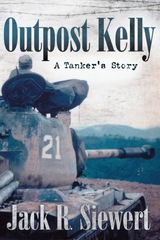 Outpost Kelly: A Tanker's Story
Jack R. Siewert, with a foreword by Paul M Edwards
University of Alabama Press, 2006 In July 1952, Jack Siewert commanded a platoon of five M-46 tanks in Korea. In four days of battle against Chinese forces, Siewart was tasked with providing fire support for advancing infantry attempting to retake Outpost Kelly. Outpost Kelly: A Tanker's Story his a harrowing account of the success of that mission in the face of catastrophic obstacles.
Heavy rains turned the mountainous terrain around Outpost Kelly into shin-deep mud and muck. At the height of the fighting, Siewert was able to bring to bear the guns of only one of his five tanks against the enemy. Forced to abandon traditional tank warfare doctrine, he improvised. Allowing members of the 15th Infantry to retake Outpost Kelly, Siewert offers an excellent analysis of how theory and experience come together in a point-of-the-spear military situation.
Outpost Kelly also paints a fascinating picture of the type of fighting, often overlooked, that characterized the second and third years of the Korean War. With truce talks proceeding in Panmunjom, both sides fought to claim incremental pieces of real estate along the demarcation line between North and South.
Output Measurement in the Service Sectors
Edited by Zvi Griliches
University of Chicago Press, 1992 Is the fall in overall productivity growth in the United States and other developed countries related to the rising share of the service sectors in the economy? Since services represent well over half of the U.S. gross national product, it is also important to ask whether these sectors have had a slow rate of growth, as this would act as a major drag on the productivity growth of the overall economy and on its competitive performance. In this timely volume, leading experts from government and academia argue that faulty statistics have prevented a clear understanding of these issues.
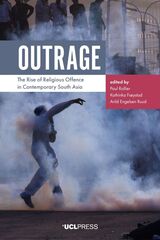 Outrage: The Rise of Religious Offence in Contemporary South Asia
Edited by Paul Rollier, Kathinka Frøystad, and Arild Engelsen Ruud
University College London, 2019 Whether spurred by religious images or history books, hardly a day goes by in South Asia without an accusation of blasphemy. What accounts for the sharp rise in religious offense, and why it is observable across religious and political differences?
An interdisciplinary study of this trend, Outrage brings together researchers in anthropology, religious studies, and South Asian studies with rich experience in the varied ways religion and politics intersect in this region. Each chapter focuses on a recent case of alleged blasphemy or desecration in India, Pakistan, Bangladesh and Myanmar, unpacking the religious sensitivities and political concerns. Collectively, the chapters explore common denominators across national and religious differences, such as the introduction of social media and smartphones, the possible political gains of initiating blasphemy accusations, and the growing self-assertion of marginal communities.
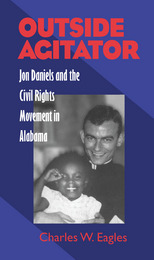 Outside Agitator: Jon Daniels and the Civil Rights Movement in Alabama
Charles Eagles
University of Alabama Press, 2000 Outside Agitator tells the dramatic, largely forgotten storybehind the 1965 killing of civil rights worker Jonathan Myrick "Jon" Daniels in Lowndes County, Alabama, detailing the lives of the killer and the victim. A white Episcopal seminary student from New Hampshire, Jon Daniels helped organize blacks in Selma during the events that led to the Selma-to-Montgomery march. In August 1965 he was fatally shot in neighboring Lowndes County by Tom Coleman, a highway department engineer and steadfast segregationist, who was later acquitted by an all-white jury. Lowndes County was a bastion of white minority dominance. For half a century, no black had voted or served on a jury there. Known for the violence used by whites to maintain their control, "bloody" Lowndes presented Daniels and other civil rights workers with almost insurmountable obstacles. Tom Coleman, a Lowndes County native, represented the consensus among local whites that violent resistance to racial change was justified. To defend his community and to prevent change, he resorted to violence against "outside agitators." Following the deaths of a score of other civil rights workers, the killing of Jon Daniels was in many ways the last atrocity of the first, southern, nonviolent phase of the Civil Rights movement. This exploration of how Daniels and Coleman came to be at opposite ends of a shotgun outside a county store captures the mechanics and emotions of forces promoting and resisting change in southern race relations. Charles Eagles reminds us that however representative Daniels and Coleman may have been of larger forces, they were nevertheless real individuals with distinctive personalities caught up in specific circumstances.
Outside in the Interior: An Adventure Guide for Central Alaska
Kyle Joly
University of Alaska Press, 2007
With its breathtaking vistas and countless acres of unmarked wilderness, Alaska has long attracted those who are looking for a bit of adventure in their vacations—from those who want to climb rugged peaks to those content to push a stroller down a paved trail. Filled with maps and photos, Outside in the Interior is the perfect guidebook for outdoor enthusiasts of all abilities. It presents detailed information about trails throughout interior Alaska, including round-trip distance, estimated hiking duration and difficulty, elevation, seasonal variations, and tips on what wildlife and other sights hikers are likely to observe along the way. Features on trail etiquette, safety, and the environment round out the volume, making Outside in the Interior an invaluable companion to any trip to America's largest state.
Outside in the Interior: An Adventure Guide for Central Alaska, Second Edition
Kyle Joly
University of Alaska Press, 2007 With its breathtaking vistas and countless acres of unmarked wilderness, Alaska has long attracted those who are looking for a bit of adventure in their vacations—from visitors who want to climb rugged peaks to those content to push a stroller down a paved trail. Filled with maps and photos, Outside in the Interior is the perfect guidebook for outdoor enthusiasts of all levels of ability. It presents detailed information about trails throughout Interior Alaska, including round-trip distance, estimated hiking duration and difficulty, elevation, seasonal variations, and tips on what wildlife and other sights hikers are likely to observe along the way. Features on trail etiquette, safety, and the environment round out the volume, making this fully up-to-date new edition of Outside in the Interior an invaluable companion to any trip to America’s largest state.
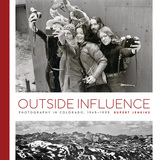 Outside Influence: Photography in Colorado, 1945–1995
Rupert Jenkins
University Press of Colorado, 2025 Outside Influence: Photography in Colorado, 1945–1995 is the first detailed account of the state’s history of post–World War II expressive photography. The title “Outside Influence” alludes to the historic presence of the natural landscape as subject and to the transformative impact of out-of-state artists and educators. Their arrival in Colorado beginning in the 1960s galvanized interpretive photography by introducing innovative concepts, nontraditional materials, and emergent digital technologies to students, peers, and their audience-at-large. Throughout the book’s nine chapters, Rupert Jenkins contextualizes Colorado photography’s postwar development with a social, political, and cultural abstract that encompasses national events and trends, the emerging presence of women and photographers of color, and institutional leadership. Drawing from more than 120 personal interviews, he identifies the medium’s principal in-state creators, mentors, and advocates from the modernist era of film processing to the emergence of interdisciplinary digital practice. Jenkins answers fundamental questions about the people and work of this era: Who generated this significant body of innovative, noncommercial photographic work? Where did they come from? Who inspired them, and who in turn did they inspire? As Eric Paddock, curator of photography at the Denver Art Museum, discusses in his foreword, by looking at the schools, workshops, galleries, and museums that supported these artists, Jenkins stresses the importance of collaboration and community to any successful venture. Crucially, in examining the lives and careers of photographers like Robert Adams, Walter Chappell, Albert Chong, Cherie Hiser, Barbara Houghton, Winter Prather, Mark Sink, Melanie Walker, Myron Wood, and numerous others, Outside Influence seeks to affirm the medium’s legacy within Colorado’s fine arts canon.
Outside Is the Ocean
Matthew Lansburgh
University of Iowa Press, 2017 Three days after her twentieth birthday, a young woman who grew up in Germany during World War II crosses the Atlantic to start a new life. Outside Is the Ocean traces Heike’s struggle to find love and happiness in America. After two marriages and a troubled relationship with her son, Heike adopts a disabled child from Russia, a strong-willed girl named Galina, who Heike hopes will give her the affection and companionship she craves. As Galina grows up, Heike’s grasp on reality frays, and she writes a series of letters to the son she thinks has abandoned her forever. It isn’t until Heike’s death that her son finds these letters and realizes how skewed his mother’s perceptions actually were.
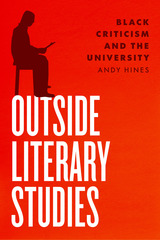 Outside Literary Studies: Black Criticism and the University
Andy Hines
University of Chicago Press, 2022 A timely reconsideration of the history of the profession, Outside Literary Studies investigates how midcentury Black writers built a critical practice tuned to the struggle against racism and colonialism.
This striking contribution to Black literary studies examines the practices of Black writers in the mid-twentieth century to revise our understanding of the institutionalization of literary studies in America. Andy Hines uncovers a vibrant history of interpretive resistance to university-based New Criticism by Black writers of the American left. These include well-known figures such as Langston Hughes and Lorraine Hansberry as well as still underappreciated writers like Melvin B. Tolson and Doxey Wilkerson. In their critical practice, these and other Black writers levied their critique from “outside” venues: behind the closed doors of the Senate Permanent Subcommittee on Investigations, in the classroom at a communist labor school under FBI surveillance, and in a host of journals. From these vantages, Black writers not only called out the racist assumptions of the New Criticism, but also defined Black literary and interpretive practices to support communist and other radical world-making efforts in the mid-twentieth century. Hines’s book thus offers a number of urgent contributions to literary studies: it spotlights a canon of Black literary texts that belong to an important era of anti-racist struggle, and it fills in the pre-history of the rise of Black studies and of ongoing Black dissent against the neoliberal university.
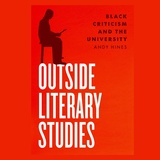 Outside Literary Studies: Black Criticism and the University
Andy Hines
University of Chicago Press, 2022 This is an auto-narrated audiobook edition of this book. A timely reconsideration of the history of the profession, Outside Literary Studies investigates how midcentury Black writers built a critical practice tuned to the struggle against racism and colonialism.
This striking contribution to Black literary studies examines the practices of Black writers in the mid-twentieth century to revise our understanding of the institutionalization of literary studies in America. Andy Hines uncovers a vibrant history of interpretive resistance to university-based New Criticism by Black writers of the American left. These include well-known figures such as Langston Hughes and Lorraine Hansberry as well as still underappreciated writers like Melvin B. Tolson and Doxey Wilkerson. In their critical practice, these and other Black writers levied their critique from “outside” venues: behind the closed doors of the Senate Permanent Subcommittee on Investigations, in the classroom at a communist labor school under FBI surveillance, and in a host of journals. From these vantages, Black writers not only called out the racist assumptions of the New Criticism, but also defined Black literary and interpretive practices to support communist and other radical world-making efforts in the mid-twentieth century. Hines’s book thus offers a number of urgent contributions to literary studies: it spotlights a canon of Black literary texts that belong to an important era of anti-racist struggle, and it fills in the pre-history of the rise of Black studies and of ongoing Black dissent against the neoliberal university.
Outside Passage: A Memoir of an Alaskan Childhood
Julia Scully
University of Alaska Press, 2010 When Julia Scully was seven years old, her father committed suicide, and she and her sister were sent to an orphanage. Two years later, emotionally damaged by the isolation and brutality of the orphanage, the girls followed their mother to the near-wilderness of the gold-mining territory north of Nome, Alaska, where she had leased a roadhouse in the tiny settlement of Taylor. Julia had no idea what to expect when she arrived, but to her surprise, she found a healing power in the stark beauty of the vast tundra. Later, she reveled in the boisterous, chaotic boomtown atmosphere that prevailed when thousands of American troops descended on Nome at the outbreak of World War II.
Outside Passage is a lyrical and affecting memoir of those years, simultaneously an emotional account of a young girl’s first steps into adulthood and a unique portrait of a vanished frontier life.
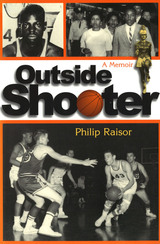 Outside Shooter: A Memoir
Philip Raisor
University of Missouri Press, 2003
Philip Raisor was on the losing side in two of the most storied basketball games ever played. He started at guard for the Muncie Central Bearcats, who fell in the 1954 Indiana state final to tiny Milan, the David-over-Goliath event that inspired the movie Hoosiers. On a basketball scholarship to the University of Kansas, he watched his Wilt Chamberlain–led Jayhawks lose the 1957 NCAA championship in triple overtime to North Carolina. In Outside Shooter, Raisor recounts the hard knocks and hard-won triumphs of a basketball odyssey across 1950s America, from Indiana to Kansas to Louisiana, and from adolescence to adulthood.
This was an era in which a racially divided society was taking halting steps toward integration, and few places held more tension than the sports arena. Raisor saw firsthand the toll of racism in the inner rage and sorrow of Muncie’s star player, John Casterlow, whose life followed a trajectory from playing the legendary Oscar Robertson to a draw—almost—to death in the streets of Detroit at age twenty-three. Later, at Louisiana State University after having transferred from Kansas, Raisor, spurred by the memory of Casterlow, would join in hazardous early attempts to integrate the LSU campus. From Indiana to Louisiana, he sees the ordeal of racism reveal character—including his own—at depths beyond the illumination even of competitive sport.
Devoted though Raisor was to basketball, Outside Shooter captures the period of his life in which he gradually stopped defining himself in terms of the game. As the rise and fall of his fortunes on the basketball court become overshadowed by the shifting patterns of his larger life—the competing measures of acceptance and expectation from his family and companions; the courage and challenge offered by a young woman equally bent on accomplishment; his struggles with failure and doubt juxtaposed with his awakening intellect and conscience—he discovers the sense of purpose that will carry him beyond his playing days and into adulthood as a budding writer.
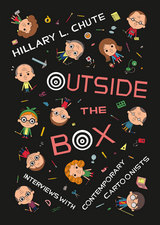 Outside the Box: Interviews with Contemporary Cartoonists
Hillary L. Chute
University of Chicago Press, 2014 We are living in a golden age of cartoon art. Never before has graphic storytelling been so prominent or garnered such respect: critics and readers alike agree that contemporary cartoonists are creating some of the most innovative and exciting work in all the arts.
For nearly a decade Hillary L. Chute has been sitting down for extensive interviews with the leading figures in comics, and with Outside the Box she offers fans a chance to share her ringside seat. Chute’s in-depth discussions with twelve of the most prominent and accomplished artists and writers in comics today reveal a creative community that is richly interconnected yet fiercely independent, its members sharing many interests and approaches while working with wildly different styles and themes. Chute’s subjects run the gamut of contemporary comics practice, from underground pioneers like Art Spiegelman and Lynda Barry, to the analytic work of Scott McCloud, the journalism of Joe Sacco, and the extended narratives of Alison Bechdel, Charles Burns, and more. They reflect on their experience and innovations, the influence of peers and mentors, the reception of their art and the growth of critical attention, and the crucial place of print amid the encroachment of the digital age.
Beautifully illustrated in full-color, and featuring three never-before-published interviews—including the first published conversation between Art Spiegelman and Chris Ware—Outside the Box will be a landmark volume, a close-up account of the rise of graphic storytelling and a testament to its vibrant creativity.
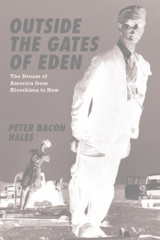 Outside the Gates of Eden: The Dream of America from Hiroshima to Now
Peter Bacon Hales
University of Chicago Press, 2014 Exhilaration and anxiety, the yearning for community and the quest for identity: these shared, contradictory feelings course through Outside the Gates of Eden, Peter Bacon Hales’s ambitious and intoxicating new history of America from the atomic age to the virtual age.
Born under the shadow of the bomb, with little security but the cold comfort of duck-and-cover, the postwar generations lived through—and led—some of the most momentous changes in all of American history. Hales explores those decades through perceptive accounts of a succession of resonant moments, spaces, and artifacts of everyday life—drawing unexpected connections and tracing the intertwined undercurrents of promise and peril. From sharp analyses of newsreels of the first atomic bomb tests and the invention of a new ideal American life in Levittown; from the music emerging from the Brill Building and the Beach Boys, and a brilliant account of Bob Dylan’s transformations; from the painful failures of communes and the breathtaking utopian potential of the early days of the digital age, Hales reveals a nation, and a dream, in transition, as a new generation began to make its mark on the world it was inheriting.
Full of richly drawn set-pieces and countless stories of unforgettable moments, Outside the Gates of Eden is the most comprehensive account yet of the baby boomers, their parents, and their children, as seen through the places they built, the music and movies and shows they loved, and the battles they fought to define their nation, their culture, and their place in what remains a fragile and dangerous world.
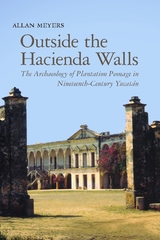 Outside the Hacienda Walls: The Archaeology of Plantation Peonage in Nineteenth-Century Yucatán
Allan Meyers
University of Arizona Press, 2012 The Mexican Revolution was a tumultuous struggle for social and political reform that ousted an autocrat and paved the way for a new national constitution. The conflict, however, came late to Yucatán, where a network of elite families with largely European roots held the reins of government. This privileged group reaped spectacular wealth from haciendas, cash-crop plantations tended by debt-ridden servants of Maya descent. When a revolutionary army from central Mexico finally gained a foothold in Yucatán in 1915, the local custom of agrarian servitude met its demise.
Drawing on a dozen years of archaeological and historical investigation, Allan Meyers breaks new ground in the study of Yucatán haciendas. He explores a plantation village called San Juan Bautista Tabi, which once stood at the heart of a vast sugar estate. Occupied for only a few generations, the village was abandoned during the revolutionary upheaval. Its ruins now lie within a state-owned ecological reserve.
Through oral histories, archival records, and physical remains, Meyers examines various facets of the plantation landscape. He presents original data and fresh interpretations on settlement organization, social stratification, and spatial relationships. His systematic approach to "things underfoot," small everyday objects that are now buried in the tropical forest, offers views of the hacienda experience that are often missing in official written sources. In this way, he raises the voices of rural, mostly illiterate Maya speakers who toiled as laborers. What emerges is a portrait of hacienda social life that transcends depictions gleaned from historical methods alone.
Students, researchers, and travelers to Mexico will all find something of interest in Meyers's lively presentation. Readers will see the old haciendas—once forsaken but now experiencing a rebirth as tourist destinations—in a new light. These heritage sites not only testify to social conditions that prevailed before the Mexican Revolution, but also remind us that the human geography of modern Yucatán is as much a product of plantation times as it is of more ancient periods.
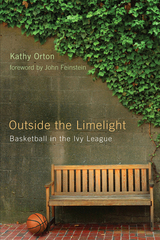 Outside the Limelight: Basketball in the Ivy League
Orton, Kathy
Rutgers University Press, 2018 The Ivy League is a place where basketball is neither a pastime nor a profession. Instead, it is a true passion among players, coaches, and committed sports enthusiasts who share in its every success and setback. Outside the Limelight is the first book to look inside Ivy League basketball and at the boundless enthusiasm that defines it. With painstaking reportage, Kathy Orton vividly captures the internal fervor of the personalities who champion their gameùall the triumphs and disappointments of an Ivy hoop season. Scholarships for student athletes? None, and this is the only Division I conference that does not offer them. The TV spotlight? It barely shines, despite the passion, talent, and commitment of the players. Megadollar contracts from the NBA? Rarely does a player receive an offer. These age-old institutions are better known for turning out presidents, not point guards, and CEOs and captains of industry, not centers on the court. Orton weaves together the stories of coaches and players as they move from fall practice through an entire season and ahead to the NCAA tournament. From Harvard to Penn, Princeton to Cornell and beyond, playersùperhaps more accustomed to pomp and circumstanceùface leaky gyms, endure long bus rides, rigorous courseloads, and unbearable exam schedules. Why? Just to prove they can hang with the big boys despite juggling multiple non-athletic responsibilities? Maybe. But more importantly, for the sincere love of the game. Outside the Limelight provides frontcourt vision for college basketball fans everywhere to achieve an appreciation of this captivating conference and for diehard enthusiasts to gain greater insight into what brings Ivy League basketball to center circle.
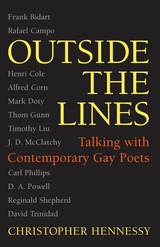 Outside the Lines: Talking with Contemporary Gay Poets
Christopher Hennessy, Editor
University of Michigan Press, 2005 "Outside the Lines explores the personal and historical forces that have shaped the work of a dozen gifted poets. The answers given to Hennessy's astute, perfectly tailored questions remind a reader how exciting poetry can be, and how writers create, through language, the world as we have never known it. These adventuresome interviews will stir anyone who cares about the making of art."
---Bernard Cooper, author of Maps to Anywhere
Editor Christopher Hennessy gathers interviews with some of the most significant figures in contemporary American poetry. While each poet is gay, these encompassing, craft-centered interviews reflect the diversity of their respective arts and serve as a testament to the impact gay poets have had and will continue to have on contemporary poetics.
The book includes twelve frank, intense interviews with some of America's best-known and loved poets, who have not only enjoyed wide critical acclaim but who have had lasting impact on both the gay tradition and the contemporary canon writ large, for example, Frank Bidart, the late Thom Gunn, and J. D. McClatchy. Some of the most honored and respected poets, still in the middle of their careers, are also included, for example, Mark Doty, Carl Phillips, and Reginald Shepherd. Each interview explores the poet's complete work to date, often illuminating the poet's technical evolution and emotional growth, probing shifts in theme, and even investigating links between verse and sexuality.
In addition to a selected bibliography of works by established poets, the book also includes a list of works by newer and emerging poets who are well on their way to becoming important voices of the new millennium.
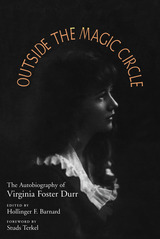 Outside the Magic Circle: The Autobiography of Virginia Foster Durr
Hollinger F. Barnard
University of Alabama Press, 1990 Winner of the Alabama Library Author Award Outside the Magic Circle tells the remarkable story of Virginia Foster Durr, a southern white woman born into privilige who (along with her husband Clifford Durr, a lawyer best known for defending Rosa Parks), nonetheless devoted her life to Civil Rights activism. Outside the Magic Circle is the powerful and deeply personal autobiography of Virginia Foster Durr, a Southern woman who defied the expectations of her privileged upbringing to become one of the most courageous voices for civil rights and social justice in 20th-century America. Born into a wealthy, white Alabama family, Durr was raised in a world steeped in segregation and conservative values. Yet through a journey marked by moral reckoning, intellectual awakening, and political activism, she stepped outside the “magic circle” of Southern gentility to confront the injustices that shaped her world. With a foreword by renowned oral historian Studs Terkel, this memoir captures Durr’s transformation from reluctant conformist to outspoken advocate. Her story spans decades of American history—from the Great Depression and New Deal politics to the McCarthy era and the Civil Rights Movement. Alongside her husband, attorney Clifford Durr, Virginia became a key figure in progressive circles, working to abolish the poll tax, defend civil liberties, and support Black activists in the segregated South. Told in Durr’s own voice, the narrative is rich with anecdotes, reflections, and encounters with historical figures such as Eleanor Roosevelt, Rosa Parks, and Martin Luther King Jr. It is both a personal reckoning and a political document, offering rare insight into the inner conflicts of white Southern liberals and the cost of dissent in a deeply divided society. Outside the Magic Circle is more than a memoir—it is a testament to the power of conscience, the courage of transformation, and the enduring fight for justice. It remains a vital resource for readers interested in civil rights history, feminist thought, and the complexities of Southern identity.
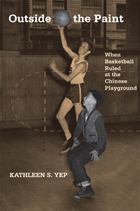 Outside the Paint: When Basketball Ruled at the Chinese Playground
Kathleen S. Yep
Temple University Press, 2009 Outside the Paint takes readers back to the Chinese Playground of San Francisco in the 1930s and 1940s, the only public outdoor space in Chinatown. It was a place where young Chinese American men and women developed a new approach to the game of basketbal—with fast breaks, intricate passing and aggressive defense—that was ahead of its time. Drawing on interviews with players and coaches, Kathleen Yep recounts some surprising stories. From the success of the Hong Wah Kues, a professional barnstorming men's basketball team and the Mei Wahs, a championship women’s amateur team, to Woo Wong, the first Chinese athlete to play in Madison Square Garden, and his extraordinarily talented sister Helen Wong, who is compared to Babe Didrikson. Outside the Paint chronicles the efforts of these highly accomplished athletes who developed a unique playing style that capitalized on their physical attributes, challenged the prevailing racial hierarchy, and enabled them, for a time, to leave the confines of their segregated world. As they learned to dribble, shoot, and steal, they made basketball a source of individual achievement and Chinese American community pride.
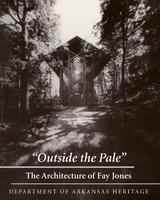 Outside the Pale: The Architecture of Fay Jones
Department of Arkansas Heritage
University of Arkansas Press, 1999 Honored with the 1990 American Institute of Architects Gold Medal for a lifetime of outstanding achievement, Fay Jones is an Arkansas original. In receiving the medal from Prince Charles of Great Britain, Jones was hailed as a “powerful and special genius who embodies nearly all the qualities we admire in an architect” and as an artist who used his vision to craft “mysterious and magical places” not only in Arkansas but all over the world. This book accompanied a special museum exhibit of Jones’s life and work at the Old State House in Little Rock. It traces Jones’s development from his early years as a student of Frank Lloyd Wright and Bruce Goff, to the culmination of his ability in such arresting structures as Pinecote Pavilion in Picayune, Mississippi; Thorncrown Chapel in Eureka Springs, Arkansas; and Chapman University Chapel in Orange, California. Through the black-and-white photographs of the homes, chapels, and other buildings that Jones has created and the accompanying captions and interviews of the architect, the reader is allowed a view into this man’s remarkable talent. Designing structures that fuse architecture and landscape, the organic and the man-made, Jones has created special places which touch their viewers with the power and subtlety of poetry. Herein we learn why. From the Foreword by Robert Adams Ivy Jr.: “Fay Jones’s architecture begins in order and ends in mystery. . . . His role can perhaps best be understood as mediator, a human consciousness that has arisen from the Arkansas soil and scoured the cosmos, then spoken through the voices of stone and wood, steel and glass. Art, philosophy, craft, and human aspiration coalesce in his masterworks, transformed from acts of will into harmonies: Jones lets space sing.”
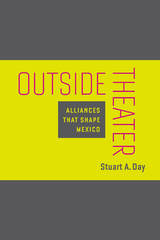 Outside Theater: Alliances That Shape Mexico
Stuart A. Day
University of Arizona Press, 2017 Taking a cue from influential French philosopher Jacques Rancière, who in The Emancipated Spectator rejects the idea of the passive, ignorant, duped spectators in need of instruction to become active, Stuart A. Day’s goal in Outside Theater is to highlight written words and performances that exemplify effective strategies, past and present, to reveal and promote civic engagement, to provoke disruptions, or to highlight fissures—and opportunities—in oppressive social structures. Through the study of one or two primary models per chapter, as well as multiple examples in the introduction and conclusion, Day presents Mexican plays from 1905 to 2015, including the 2010 Mexico City performance of Zoot Suit by Chicano playwright Luis Valdez. Using these plays, Day explores the concept of “outside theater,” where people or groups translate the tools of the theatrical trade to a different stage, outside the walls of the theater, and play the part of fictional or real life Celestinas—matchmakers who unite seemingly disparate entities to promote social awareness and social action by working the borders between life and art. Each work in this innovative analysis reveals productive social connections that, with the help of crucial artistic alliances, contradict the perception that art is somehow secondary to or disconnected from the public sphere of influence and the struggles of everyday life. With this book, Day shows that Mexican theater can and does bolster civil society and thus the country’s fragile democracy.
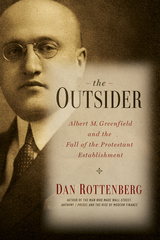 The Outsider: Albert M. Greenfield and the Fall of the Protestant Establishment
Dan Rottenberg
Temple University Press, 2018 Albert M. Greenfield (1887-1967), an ambitious immigrant outsider, was courted for his business acumen by mayors, senators, governors, and presidents, including Franklin Roosevelt and Harry Truman. As this feisty Russian Jew built a business empire that encompassed real estate, stores (including Bonwit Teller and Tiffany's), hotels (including the Ben Franklin and the Bellevue-Stratford), banks, newspapers, transportation companies, and even the Loft Candy Corporation, he challenged the entrenched business elite. Greenfield was also instrumental in bringing both major political conventions to Philadelphia in 1948.
In The Outsider, veteran journalist and best-selling author Dan Rottenberg deftly chronicles the astonishing rises, falls, and countless reinventions of this savvy businessman. Greenfield's power allowed him to cross social, religious, and ethnic boundaries with impunity. He alarmed Philadelphia's conservative business and social leaders-Christians and Jews alike-some of whom plotted his downfall.
In this engaging account of Greenfield's fascinating life, Rottenberg demonstrates the extent to which one uniquely brilliant and energetic man pushed the boundaries of society's limitations on individual potential. The Outsider provides a microcosmic look at three twentieth-century upheavals: the rise of Jews as a crucial American business force, the decline of America's Protestant establishment, and the transformation of American cities.
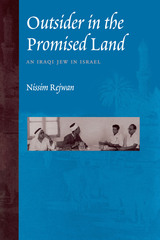 Outsider in the Promised Land: An Iraqi Jew in Israel
By Nissim Rejwan
University of Texas Press, 2006 In 1951, Israel was a young nation surrounded by hostile neighbors. Its tenuous grip on nationhood was made slipperier still by internal tensions among the various communities that had immigrated to the new Jewish state, particularly those between the politically and socially dominant Jewish leadership hailing from Eastern Europe and the more numerous Oriental Jews from the Middle East and North Africa. Into this volatile mix came Nissim Rejwan, a young Iraqi Jewish intellectual who was to become one of the country's leading public intellectuals and authors. Beginning with Rejwan's arrival in 1951 and climaxing with the tensions preceding Israel's victory in the Six-Day War of 1967, this book colorfully chronicles Israel's internal and external struggles to become a nation, as well as the author's integration into a complex culture. Rejwan documents how the powerful East European leadership, acting as advocates of Western norms and ideals, failed to integrate Israel into the region and let the country take its place as a part of the Middle East. Rejwan's essays and occasional articles are an illuminating example of how minority groups use journalism to gain influence in a society. Finally, the letters and diary entries reproduced in Outsider in the Promised Land are full of lively, witty meditations on history, literature, philosophy, education, and art, as well as one man's personal struggle to find his place in a new nation.
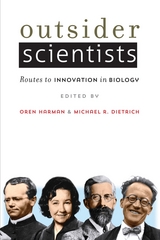 Outsider Scientists: Routes to Innovation in Biology
Edited by Oren Harman and Michael R. Dietrich
University of Chicago Press, 2013 Outsider Scientists describes the transformative role played by “outsiders” in the growth of the modern life sciences. Biology, which occupies a special place between the exact and human sciences, has historically attracted many thinkers whose primary training was in other fields: mathematics, physics, chemistry, linguistics, philosophy, history, anthropology, engineering, and even literature. These outsiders brought with them ideas and tools that were foreign to biology, but which, when applied to biological problems, helped to bring about dramatic, and often surprising, breakthroughs. This volume brings together eighteen thought-provoking biographical essays of some of the most remarkable outsiders of the modern era, each written by an authority in the respective field. From Noam Chomsky using linguistics to answer questions about brain architecture, to Erwin Schrödinger contemplating DNA as a physicist would, to Drew Endy tinkering with Biobricks to create new forms of synthetic life, the outsiders featured here make clear just how much there is to gain from disrespecting conventional boundaries. Innovation, it turns out, often relies on importing new ideas from other fields. Without its outsiders, modern biology would hardly be recognizable.
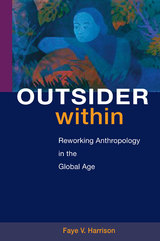 Outsider Within: Reworking Anthropology in the Global Age
Faye Harrison
University of Illinois Press, 2007 Outsider Within presents an approach to critically reconstructing the anthropology discipline to better encompass issues of gender and race. Among the nine key changes to the field that Faye V. Harrison advocates are researching in an ethically and politically responsible manner, promoting greater diversity in the discipline, rethinking theory, and committing to a genuine multicultural dialogue. In drawing from materials developed during her distinguished twenty-five year career in Caribbean and African American studies, Harrison analyzes anthropology’s limits and possibilities from an African American woman’s perspective, while also recognizing similarities between peoples, despite social, cultural, and political differences. In seeking to productively engage anthropologists of diverse geographical, cultural, and national origins, Harrison challenges them to work together to transcend stark gender, racial, and national hierarchies.
Outsiders and Openness in the Presidential Nominating System
Andrew E. Busch
University of Pittsburgh Press, 1997 Outsiders and Openness in the Presidential Nominating System examines the relationship of outsiders to the presidential nominating system since the late nineteenth century. He studies in depth the campaigns of Estes Kefauver, Barry Goldwater, George Wallace, Eugene McCarthy, George McGovern, Jimmy Carter, Gary Hart, Paul Tsongas, Jerry Brown, and Ross Perot.
Outsiders in 19th-Century Press History: Multicultural Perspectives
Frankie Hutton
University of Wisconsin Press, 1995 This anthology of journalism history brings together essays on the early Black press, pioneer Jewish journalism, Spanish-language newspapers, Native American newspapers, woman suffrage, peace advocacy, and Chinese American and Mormon publications. It shows how marginal groups developed their own journalism to counter the prejudices and misconceptions of the white establishment press. The essays address the important questions of freedom of expression in religious matters as well as the domains of race and gender.
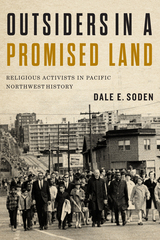 Outsiders in a Promised Land: Religious Activists in Pacific Northwest History
Dale Soden
Oregon State University Press, 2015 Outsiders in a Promised Land explores the role that religious activists have played in shaping the culture of the Pacific Northwest, particularly in Washington and Oregon, from the middle of the 19th century onward. The region’s earliest settlers came to work in the mines and forests, and a culture of saloons, gambling halls, and brothels grew up to serve them. When migration to the region intensified, newcomers with families and religious traditions often saw themselves as outsiders in opposition to the prevailing frontier culture.
As communities grew in population, early activists found common ground in a desire to protect women and children, and make their towns more hospitable to religious values. Protestants, Catholics, and Jews worked together to transform communities. Together they introduced public and private schools, health care institutions, libraries and orphanages, and lobbied for the prohibition of alcohol.
Beginning in the 1930s, religious activism played a crucial role in the emerging culture wars between liberals and conservatives. Liberals rallied around the protection of civil rights and the building of social safety nets, while conservatives decried the rise of secularism, liberalism, and communism. Today, religious activists of many faiths are deeply engaged in matters related to women’s and gay rights, foreign policy, and environmental protection.
Outsiders in a Promised Land is a meticulously researched, comprehensive treatment of religion in Pacific Northwest public life from the middle of the nineteenth century to the present. The first book of its kind, it is destined to be an essential reference for scholars, activists, and religious leaders of all faiths.
 Outsiders: The Humanity and Inhumanity of Giants in Medieval French Prose
Sylvia Huot
University of Notre Dame Press, 2016 Giants are a ubiquitous feature of medieval romance. As remnants of a British prehistory prior to the civilization established, according to the Historium regum Britannie, by Brutus and his Trojan followers, giants are permanently at odds with the chivalric culture of the romance world. Whether they are portrayed as brute savages or as tyrannical pagan lords, giants serve as a limit against which the chivalric hero can measure himself. In Outsiders: The Humanity and Inhumanity of Giants in Medieval French Prose Romance, Sylvia Huot argues that the presence of giants allows for fantasies of ethnic and cultural conflict and conquest, and for the presentation—and suppression—of alternative narrative and historical trajectories that might have made Arthurian Britain a very different place.
Focusing on medieval French prose romance and drawing on aspects of postcolonial theory, Huot examines the role of giants in constructions of race, class, gender, and human subjectivity. She selects for study the well-known prose Lancelot and the prose Tristan, as well as the lesser known Perceforest, Le Conte du papegau, Guiron le Courtois, and Des Grantz Geants. By asking to what extent views of giants in Arthurian romance respond to questions that concern twenty-first-century readers, Huot demonstrates the usefulness of current theoretical concepts and the issues they raise for rethinking medieval literature from a modern perspective.
"In her beautifully written Outsiders: The Humanity and Inhumanity of Giants in Medieval French Prose Romance, Sylvia Huot organizes a wealth of material into a taxonomy of giants and their complex role in medieval French literature. Huot imaginatively uses that mapping to demonstrate the many ways in which the figure of the giant is a cultural fantasy through which medieval writers imagined the limits of personhood. Tracing that fantasy through medieval concepts of race and ethnicity, Huot makes an original and important claim not just about what giants do for medieval writers or their audiences, but also about the vulnerable boundaries of the human that are both put into question and reaffirmed by representations of giant outsiders."
—Peggy McCracken, University of Michigan
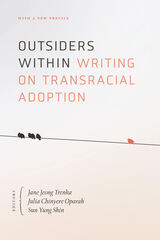 Outsiders Within: Writing on Transracial Adoption
Jane Jeong Trenka
University of Minnesota Press, 2020 Confronting trauma behind the transnational adoption system—now back in print
Many adoptees are required to become people that they were never meant to be. While transracial adoption tends to be considered benevolent, it often exacts a heavy emotional, cultural, and economic toll on those who directly experience it. Outsiders Within is a landmark publication that carefully explores this most intimate aspect of globalization through essays, fiction, poetry, and art. Moving beyond personal narrative, transracially adopted writers from around the world tackle difficult questions about how to survive the racist and ethnocentric worlds they inhabit, what connects the countries relinquishing their children to the countries importing them, why poor families of color have their children removed rather than supported—about who, ultimately, they are. In their inquiry, the contributors unseat conventional understandings of adoption politics, reframing the controversy as a debate that encompasses human rights, peace, and reproductive justice.
Contributors: Heidi Lynn Adelsman; Ellen M. Barry; Laura Briggs, U of Massachusetts, Amherst; Catherine Ceniza Choy, U of California, Berkeley; Gregory Paul Choy, U of California, Berkeley; Rachel Quy Collier; J. A. Dare; Kim Diehl; Kimberly R. Fardy; Laura Gannarelli; Shannon Gibney; Mark Hagland; Perlita Harris; Tobias Hübinette, Stockholm U; Jae Ran Kim; Anh Đào Kolbe; Mihee-Nathalie Lemoine; Beth Kyong Lo; Ron M.; Patrick McDermott, Salem State College, Massachusetts; Tracey Moffatt; Ami Inja Nafzger (aka Jin Inja); Kim Park Nelson; John Raible; Dorothy Roberts, Northwestern U; Raquel Evita Saraswati; Kirsten Hoo-Mi Sloth; Soo Na; Shandra Spears; Heidi Kiiwetinepinesiik Stark; Kekek Jason Todd Stark; Sunny Jo; Sandra White Hawk; Indigo Williams Willing; Bryan Thao Worra; Jeni C. Wright.
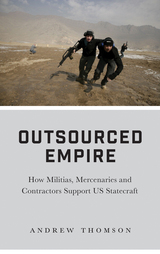 Outsourced Empire: How Militias, Mercenaries and Contractors Support US Statecraft
Andrew Thompson
Pluto Press, 2018 The way that imperial power is enacted around the world today has changed, but it has received little attention. Outsourced Empire aims to change that, re-evaluating the history of empire from the Cold War to the present by looking at the influence of para-state actors. A para-state is a region that seeks or claims, but does not officially have, the status of an independent state. From the Guatemalan coup to the Bay of Pigs, from Syrian rebel factions to the Soviet-Afghan War, Andrew Thomson pulls together seemingly disparate events and groups to reveal the ways that para-states have become central to US imperialism, enabling the United States to influence political and economic conditions abroad in secret. Drawing on a wide range of sources, including US training manuals, CIA communiqués, and National Security Agency archives, Thomson reveals the hidden workings of contemporary empire.
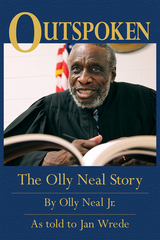 Outspoken: The Olly Neal Story
Olly Neal
Butler Center for Arkansas Studies, 2020 Born in 1941 on a farm near Marianna in rural eastern Arkansas, Olly Neal Jr. grew up in a large family with parents who insisted on their children getting a good education. Neal had the intellect but not the temperament to be a good student in high school, but a teacher took an interest in him when she saw him steal a book rather than risk his tough-guy reputation if someone saw him checking it out. Neal went on to start and lead the Lee County Cooperative Clinic in Marianna during the 1970s, a turbulent time fraught with conflicts between the white power structure and black citizens seeking their civil rights and increased economic opportunities. (The clinic remains a prominent community health center.) He became the first black district prosecuting attorney in Arkansas, and then served as a circuit court judge and on the Arkansas Court of Appeals. Historian Grif Stockley has characterized Neal as a civil rights activist, political agitator, Arkansas Delta advocate, and “black devil incarnate” to many of Marianna’s whites.
His road to success was not a smooth one, and Neal tells his unique story with humor, candor, and hard-earned wisdom, explaining his rocky journey from hardscrabble beginnings in rural Lee County to the role of prosecutor to the judicial bench. Along the way, many whites saw him as a threat to the established order and many blacks saw him as a traitor who was prosecuting and sitting in judgment of his own people. But Neal emphasized fairness and equal treatment at every opportunity, saying, “The way I got past all of this was by talking to my people about what I did and why, and by telling them how difficult it was for me. And I think that many folks understood me.” Looking back on these years and the people he met along the way, he offers insights into the traumas of the time and the toll they took on his mental and physical health, as well as the relationships that helped him face these challenges.
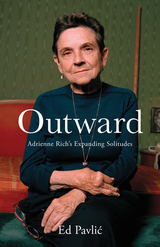 Outward: Adrienne Rich’s Expanding Solitudes
Ed Pavlic
University of Minnesota Press, 2021 The first scholarly study of Adrienne Rich’s full career examines the poet through her developing approach to the transformative potential of relationships
Adrienne Rich is best known as a feminist poet and activist. This iconic status owes especially to her work during the 1970s, while the distinctive political and social visions she achieved during the second half of her career remain inadequately understood. In Outward, poet, scholar, and novelist Ed Pavlić considers Rich’s entire oeuvre to argue that her most profound contribution in poems is her emphasis on not only what goes on “within us” but also what goes on “between us.” Guided by this insight, Pavlić shows how Rich’s most radical work depicts our lives—from the public to the intimate—in shared space rather than in owned privacy. Informed by Pavlić’s friendship and correspondence with Rich, Outward explores how her poems position visionary possibilities to contend with cruelty and violence in our world. Employing an innovative framework, Pavlić examines five kinds of solitude reflected in Rich’s poems: relational solitude, social solitude, fugitive solitude, dissident solitude, and radical solitude. He traces the importance of relationships to her early writing before turning to Rich’s explicitly antiracist and anticapitalist work in the 1980s, which culminates with her most extensive sequence, “An Atlas of the Difficult World.” Pavlić concludes by examining the poet’s twenty-first century work and its depiction of relationships that defy historical divisions based on region, race, class, gender, and sexuality. A deftly written engagement in which one poet works within the poems of another, Outward reveals the development of a major feminist thinker in successive phases as Rich furthers her intimate and erotic, social and political reach. Pavlić illuminates Rich’s belief that social divisions and the power of capital inform but must never fully script our identities or our relationships to each other.
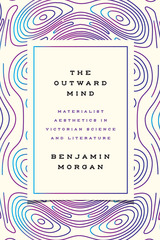 The Outward Mind: Materialist Aesthetics in Victorian Science and Literature
Benjamin Morgan
University of Chicago Press, 2017 Though underexplored in contemporary scholarship, the Victorian attempts to turn aesthetics into a science remain one of the most fascinating aspects of that era. In The Outward Mind, Benjamin Morgan approaches this period of innovation as an important origin point for current attempts to understand art or beauty using the tools of the sciences. Moving chronologically from natural theology in the early nineteenth century to laboratory psychology in the early twentieth, Morgan draws on little-known archives of Victorian intellectuals such as William Morris, Walter Pater, John Ruskin, and others to argue that scientific studies of mind and emotion transformed the way writers and artists understood the experience of beauty and effectively redescribed aesthetic judgment as a biological adaptation. Looking beyond the Victorian period to humanistic critical theory today, he also shows how the historical relationship between science and aesthetics could be a vital resource for rethinking key concepts in contemporary literary and cultural criticism, such as materialism, empathy, practice, and form. At a moment when the tumultuous relationship between the sciences and the humanities is the subject of ongoing debate, Morgan argues for the importance of understanding the arts and sciences as incontrovertibly intertwined.
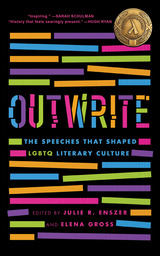 OutWrite: The Speeches That Shaped LGBTQ Literary Culture
Julie R. Enszer
Rutgers University Press, 2022 Running from 1990 to 1999, the annual OutWrite conference played a pivotal role in shaping LGBTQ literary culture in the United States and its emerging canon. OutWrite provided a space where literary lions who had made their reputations before the gay liberation movement—like Edward Albee, John Rechy, and Samuel R. Delany—could mingle, network, and flirt with a new generation of emerging queer writers like Tony Kushner, Alison Bechdel, and Sarah Schulman.
This collection gives readers a taste of this fabulous moment in LGBTQ literary history with twenty-seven of the most memorable speeches from the OutWrite conference, including both keynote addresses and panel presentations. These talks are drawn from a diverse array of contributors, including Allen Ginsberg, Judy Grahn, Essex Hemphill, Patrick Califia, Dorothy Allison, Allan Gurganus, Chrystos, John Preston, Linda Villarosa, Edmund White, and many more.
OutWrite offers readers a front-row seat to the passionate debates, nascent identity politics, and provocative ideas that helped animate queer intellectual and literary culture in the 1990s. Covering everything from racial representation to sexual politics, the still-relevant topics in these talks are sure to strike a chord with today’s readers.
The Oval Hour
Kathleen Peirce
University of Iowa Press, 1999 In The Oval Hour Kathleen Peirce addresses the vulnerability of language—which is to say the vulnerability of our reality—when we are in extreme states of desire and loss, especially erotic desire and erotic loss. Central to the book is its series of "Confessions," twenty formally similar poems that contend with the Confessions of Saint Augustine.“Passing through innocence, I came either to experience / or guilt, or they came to me, displacing innocence”: these luminous poems explore the generation and overlapping of carnal and metaphysical identities.
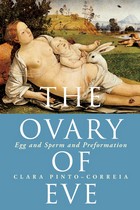 The Ovary of Eve: Egg and Sperm and Preformation
Clara Pinto-Correia
University of Chicago Press, 1997 The Ovary of Eve is a rich and often hilarious account of seventeenth- and eighteenth-century efforts to understand conception. In these early years of the Scientific Revolution, the most intelligent men and women of the day struggled to come to terms with the origins of new life, and one theory—preformation—sparked an intensely heated debate that continued for over a hundred years. Clara Pinto-Correia traces the history of this much maligned theory through the cultural capitals of Europe.
"The most wonderfully eye-opening, or imagination-opening book, as amusing as it is instructive."—Mary Warnock, London Observer
"[A] fascinating and often humorous study of a reproductive theory that flourished from the mid-17th century to the mid-18th century."—Nina C. Ayoub, Chronicle of Higher Education
"More than just a good story, The Ovary of Eve is an object lesson about the history of science: Don't trust it. . . . Pinto-Correia says she wants to tell the story of history's losers. In doing so, she makes defeat sound more appealing than victory."—Emily Eakin, Nation.
"A sparkling history of preformation as it once affected every facet of European culture."—Robert Taylor, Boston Globe
The Oven: An Anti-Lecture
Ilan Stavans
University of Massachusetts Press, 2018 After a chance meeting with a shaman in Colombia, Ilan Stavans, the highly regarded literary scholar, found himself in the Amazon rainforest. He had reluctantly agreed to participate in a religious ceremony that involved taking the hallucinogen ayahuasca. Even though he considered himself a skeptic and a rational intellectual, as someone whose worldview was defined by his education and his heritage as a Mexican Jew, Stavans found that the ritual pushed him to reconsider many of his basic understandings, including his perceptions of indigenous cultures in Latin America, as well as his career as teacher, thinker, and artist. This one-act play is delivered in the form of a lecture that mimics the author's startling spiritual journey. The book includes twenty-five bold images, in color and black and white, which capture the author's performance of the play.
 Over and Over: Performance, Time, and Resonance in Serial Television Drama
Elliott Logan
Rutgers University Press, 2026 How does serial drama earn, keep, and reward our attention for so long – over episodes, seasons, months, and years? While we know that characters are the focus of story and viewer interest in television fiction, scholars have for decades overlooked the way those characters are performed onscreen, and the lure of performance as a key formal and thematic aspect of long-form television storytelling. In Over and Over, Elliott Logan offers close readings of performance in some of the most celebrated television dramas of the century, casting new light on the attractions and significance of the medium’s seriality. The book shows how the patterning and expressive resonance of performers onscreen binds together otherwise unconnected episodes of shows like The Sopranos and Mad Men. In doing so, it highlights the provisionality of identity and meaning as crucial to their interest in the sustenance of human relationships over long periods of time. In accounting for the resonance of performance over time in serial drama, this book shows, we find the terms of our own attachment to its compelling depictions of human life
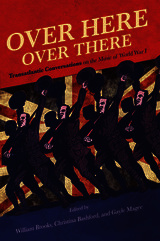 Over Here, Over There: Transatlantic Conversations on the Music of World War I
Edited by William Brooks, Christina Bashford, and Gayle Magee
University of Illinois Press, 2019 During the Great War, composers and performers created music that expressed common sentiments like patriotism, grief, and anxiety. Yet music also revealed the complexities of the partnership between France, Great Britain, Canada, and the United States. At times, music reaffirmed a commitment to the shared wartime mission. At other times, it reflected conflicting views about the war from one nation to another or within a single nation. Over Here, Over There examines how composition, performance, publication, recording, censorship, and policy shaped the Atlantic allies' musical response to the war. The first section of the collection offers studies of individuals. The second concentrates on communities, whether local, transnational, or on the spectrum in-between. Essay topics range from the sinking of the Lusitania through transformations of the entertainment industry to the influenza pandemic. Contributors: Christina Bashford, William Brooks, Deniz Ertan, Barbara L. Kelly, Kendra Preston Leonard, Gayle Magee, Jeffrey Magee, Michelle Meinhart, Brian C. Thompson, and Patrick Warfield
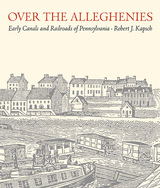 Over the Alleghenies: Early Canals and Railroads of Pennsylvania
Robert J. Kapsch
West Virginia University Press, 2013 Between 1826 and 1858 the state of Pennsylvania built and operated the largest and most technologically advanced system of canals and railroads in North America–almost one thousand miles of transport that stretched from Philadelphia to Pittsburgh and beyond. The construction of this ambitious transportation system was accompanied by great euphoria. It was widely believed that the revenue created from these canals and railroads would eliminate the need for all taxes on state citizens. Yet with the Panic of 1837, a financial crisis much like boom and bust cycle that ended in 2008, a deep recession fell across the country. By 1858, Pennsylvania had sold all canals and railroads to private companies, often for pennies-on-the-dollar. Over the Alleghenies: Early Canals and Railroads of Pennsylvania is the definitive history of the state of Pennsylvania’s incredible canal and railroad system. Although often condemned as a colossal failure, this construction effort remains an innovative, magnificent feat that ushered in modern transportation to Pennsylvania and the entire country. With extensive primary research, over one hundred illustrations, newspapers clippings, and charts and graphs, Over the Alleghenies examines and dissects the infrastructure project that bankrupted the wealthiest state in the Union.
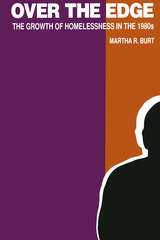 Over the Edge: The Growth of Homelessness in the 1980s
Martha M. Burt
Russell Sage Foundation, 1992 Often described as an emergency, homelessness in America is becoming a chronic condition that reflects an overall decline in the nation's standard of living and the general state of the economy. This is the disturbing conclusion drawn by Martha Burt in Over the Edge, a timely book that takes a clear-eyed look at the astonishing surge in the homeless population during the 1980s. Assembling and analyzing data from 147 U.S. cities, Burt documents the increase in homelessness and proposes a comprehensive explanation of its causes, incorporating economic, personal, and policy determinants. Her unique research answers many provocative questions: Why did homelessness continue to spiral even after economic conditions improved in 1983? Why is it significantly greater in cities with both high poverty rates and high per capita income? What can be done about the problem? Burt points to the significant catalysts of homelessness—the decline of manufacturing jobs in the inner city, the increased cost of living, the tight rental housing market, diminished household income, and reductions in public benefit programs—all of which exert pressures on the more vulnerable of the extremely poor. She looks at the special problems facing the homeless, including the growing number of mentally ill and chemically dependent individuals, and explains why certain groups—minorities and low-skilled men, single men and women, and families headed by women—are at greatest risk of becoming homeless. Burt's analysis reveals that homelessness arises from no single factor, but is instead perpetuated by pivotal interactions between external social and economic conditions and personal vulnerabilities. From an understanding of these interactions, Over the Edge builds lucid, realistic recommendations for policymakers struggling to alleviate a situation of grave consequence for our entire society.
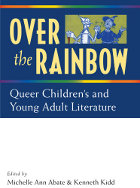 Over the Rainbow: Queer Children's and Young Adult Literature
Edited by Michelle Ann Abate and Kenneth Kidd
University of Michigan Press, 2011 "Over the Rainbow is lively, engaging, and thoughtful. More to the point, the field of children's literature needs such a collection."
---Katherine Capshaw Smith, University of Connecticut In spite of the growing critical interest concerning gender and sexual nonnormativity in and around narratives written for young readers, no book-length volume on the subject has yet appeared. Over the Rainbow: Queer Children's and Young Adult Literature is the first collection of essays dedicated to LGBTQ issues in children's literature. Bringing together significant essays and introducing new work, Over the Rainbow is intended to serve both as a scholarly reference and as a textbook for students of children's studies; gender/queer studies; and related disciplines such as English, history, sociology, and education. Editors Michelle Ann Abate and Kenneth Kidd showcase important essays on the subject of LGBTQ children's and young adult literature ---including Harriet the Spy, Rainbow Boys, Little Women, the Harry Potter series, and A Separate Peace---while providing a provisional history of both the literature and the scholarship and examining the field's origins, current status, and possible future orientations. Over the Rainbow collects essays by Jes Battis, Robin Bernstein, Thomas Crisp, June Cummins, Elizabeth A. Ford, Sherrie A. Inness, Christine A. Jenkins, Vanessa Wayne Lee, Biddy Martin, Robert McRuer, Claudia Nelson, Jody Norton, Tison Pugh, Catherine Tosenberger, Eric L. Tribunella, Roberta Seelinger Trites, and Andrea Wood. These pieces will be of interest to scholars and students in the fields of children's literature, American Studies, LGBTQ and queer studies, cultural studies, and literary criticism. Cover art: Original title page of The Wonderful Wizard of Oz, by Frank L. Baum, illustrated by W. W. Denslow. New York: George M. Hill, 1900.
Over the Range: A History of the Promontory Summit Route of the Pacific Railroad
Richard V. Francaviglia
Utah State University Press, 2008 Francaviglia looks anew at the geographical-historical context of the driving of the golden spike in May 1869. He gazes outward from the site of the transcontinental railroad's completion—the summit of a remote mountain range that extends south into the Great Salt Lake. The transportation corridor that for the first time linked America's coasts gave this distinctive region significance, but it anchored two centuries of human activity linked to the area's landscape. Francaviglia brings to that larger story a geographer's perspective on place and society, a railroad enthusiast's knowledge of trains, a cartographic historian's understanding of the knowledge and experience embedded in maps, and a desert lover's appreciation of the striking basin-and-range landscape that borders the Great Salt Lake.
Over The Rim: The Parley P. Pratt Exploring Expedition to Southern Utah, 1849-50
edited by William B. Smart and Donna T. Smart
Utah State University Press, 1999 Over the Rim is the first book about an important but little-known expedition sent by Brigham Young to explore southern Utah. Led by Mormon apostle Parley P. Pratt, the party traveled from Salt Lake City south across the rim of the Great Basin to the Virgin River near future St. George. They brought back to Mormon leaders their first detailed portrait of the country to the south that the church planned to settle.
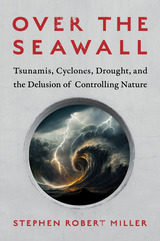 Over the Seawall: Tsunamis, Cyclones, Drought, and the Delusion of Controlling Nature
Stephen Robert Miller
Island Press, 2023 In March 2011, people in a coastal Japanese city stood atop a seawall watching the approach of the tsunami that would kill them. They believed—naively—that the huge concrete barrier would save them. Instead they perished, betrayed by the very thing built to protect them. Erratic weather, blistering drought, rising seas, and ecosystem collapse now affect every inch of the globe. Increasingly, we no longer look to stop climate change, choosing instead to adapt to it.
Never have so many undertaken such a widespread, hurried attempt to remake the world. Predictably, our hubris has led to unintended—and sometimes disastrous—consequences. Academics call it maladaptation; in simple terms, it’s about solutions that backfire. Over the Seawall tells us the stories behind these unintended consequences and about the fixes that can do more harm than good. From seawalls in coastal Japan, to the reengineered waters in the Ganges River Delta, to the artificial ribbon of water supporting both farms and urban centers in parched Arizona, Stephen Robert Miller traces the histories of engineering marvels that were once deemed too smart and too big to fail. In each he takes us into the land and culture, seeking out locals and experts to better understand how complicated, grandiose schemes led instead to failure, and to find answers to the technologic holes we’ve dug ourselves into.
Over the Seawall urges us to take a hard look at the fortifications we build and how they’ve fared in the past. It embraces humanity’s penchant for problem-solving, but argues that if we are to adapt successfully to climate change, we must recognize that working with nature is not surrender but the only way to assure a secure future.
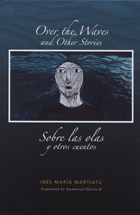 Over the Waves and Other Stories / Sobre las olas y otros cuentos: A Bilingual Edition
Inés María Martiatu
Swan Isle Press, 2009 Appearing for the first time outside of Cuba, this bold collection of short stories provides an intimate and critical view of Afro-Cuba. Inés María Martiatu’s stories—presented in a unique "split" English/Spanish edition—span postcolonial Cuba of the early twentieth century, the First Republic, the “victorious revolution,” and contemporary life in the streets of Havana. Taking real risks as an Afro-Cubana, Martiatu confronts conflicts about identity, race, marginalization, and discrimination.
The history of the Caribbean, as part of the African diaspora, is reflected in the textures of life in Cuba, its music, rituals and myths, the Church and Santería, past and present. While race is unquestionably fundamental to the stories, they are at the same time rooted in the universality of the human experience. The vantage is that of an unflinching, yet compassionate observer of society—one who simultaneously turns an introspective mirror on the complicated layers of self.
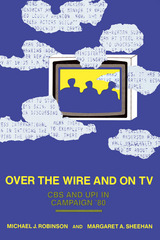 Over the Wire and on TV: CBS and UPI in Campaign '80
Michael J. Robinson
Russell Sage Foundation, 1983 First the press became the media, and now the media have become the Imperial Media—or have they? In this timely and comprehensive analysis, Michael Robinson and Margaret Sheehan examine how the news media behaved (or misbehaved) in covering the 1980 presidential campaign. Using the media's own traditional standards as a guide, Robinson and Sheehan measure the level of objectivity, fairness, seriousness, and criticism displayed by CBS News and United Press International between January and December of 1980. Drawing on statistical analyses of almost 6,000 news stories and dozens of interviews with writers and reporters, the authors reach convincing and sometimes surprising conclusions. They demonstrate, for example, that both CBS and UPI strictly avoided subjective assessments of the candidates and their positions on the issues. Both gave the major parties remarkably equal access. But the media seem to give more negative coverage to front-runners, treating serious challengers less harshly. Perhaps the most surprising finding is that networks were not more superficial than print; CBS attended to the issues at least as often as UPI. Robinson and Sheehan find television coverage more subjective, more volatile, and substantially more negative than traditional print. But CBS behaved neither imperially nor irresponsibly in Campaign '80. The networks did, however, emulate the more highly charged journalism of the eastern elite print press. By blending the quantitative techniques of social science and the tools of Washington-based journalism, Robinson and Sheehan have produced a book that will be essential reading for students and practitioners of politics, public opinion research, journalism, and communications. Lively and readable, it should also appeal to anyone interested in the role of the news media in contemporary politics.
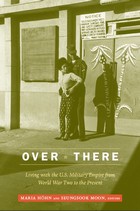 Over There: Living with the U.S. Military Empire from World War Two to the Present
Maria Höhn and Seungsook Moon, eds.
Duke University Press, 2010 Over There explores the social impact of America’s global network of more than 700 military bases. It does so by examining interactions between U.S. soldiers and members of host communities in the three locations—South Korea, Japan and Okinawa, and West Germany—where more than-two thirds of American overseas bases and troops have been concentrated for the past six decades. The essays in this collection highlight the role of cultural and racial assumptions in the maintenance of the American military base system, and the ways that civil-military relations play out locally. Describing how political, spatial, and social arrangements shape relations between American garrisons and surrounding communities, they emphasize such factors as whether military bases are located in democratic nations or in authoritarian countries where cooperation with dictatorial regimes fuels resentment; whether bases are integrated into neighboring communities or isolated and surrounded by “camp towns” wholly dependent on their business; and whether the United States sends single soldiers without families on one-year tours of duty or soldiers who bring their families and serve longer tours. Analyzing the implications of these and other situations, the contributors address U.S. military–regulated relations between GIs and local women; the roles of American women, including military wives, abroad; local resistance to the U.S. military presence; and racism, sexism, and homophobia within the U.S. military. Over There is an essential examination of the American military as a global and transnational phenomenon. Contributors
Donna Alvah
Chris Ames
Jeff Bennett
Maria Höhn
Seungsook Moon
Christopher Nelson
Robin Riley
Michiko Takeuchi
Over This Soil: An Anthology of World Farm Poems
Catherine Webster
University of Iowa Press, 1998 As a natural outgrowth from her anthology of contemporary American farm poems,Handspan of Red Earth, editor Catherine Webster has devoted herself over the past years to gathering this collection of farm poems from writers around the world. She has done her work with great energy, thoroughness, skill, and love. Over This Soil urges us to preserve our farmlands, to increase our responsibilities of land stewardship, and to intelligently maintain the agricultural necessities of our lives. It is an important agricultural and literary document for our planet at this time.
 Overbuilt: The High Costs and Low Rewards of US Highway Construction
Erick Guerra
Island Press, 2025 The world’s largest public works investment visible from space, the Interstate Highway System and the hundreds of thousands of miles of supporting roadways, are frequently hailed as a marvel and triumph of engineering. President Eisenhower’s 1956 Interstate Highway Act is often praised as a model of successful bipartisanship.
Today, the extensive damage wreaked by the creation of the highway system and the ills of car dependency are more widely acknowledged. Congestion and traffic deaths remain endemic despite nearly three-quarters a century of public policies and trillions of dollars spent with a primary stated goal of reducing congestion and improving traffic safety. The financing, governance, and construction models established by the 1956 act continue to influence what gets built today.
In Overbuilt: The High Costs and Low Rewards of US Highway Construction, transportation planning expert Erick Guerra describes how the US roadway system became overbuilt, how public policy continues to encourage overbuilding, what the scale and consequences of overbuilding are, and how we can rethink our approach to highway building in the US.
Guerra explains that the national propensity to build roadways is no longer official or intentional policy. Instead, overbuilding stems from the institutions, finance mechanisms, and evaluation metrics developed in the first half of the twentieth century. While more funds are set aside for transit, walking, biking, and beautification, the investment paradigm has not changed. Planners and engineers have not adjusted the tools they use to determine which roads should be built, rebuilt, or widened and why. The country has added more lanes of urban Interstate since declaring the Interstate system complete than prior to it.
Despite having too much roadway, the country is still operating in construction mode, using the same basic approach used to finance and build the interstate system quickly, Guerra states. The interstate was completed more than three decades ago. Overbuilt argues convincingly that it is time to move on.
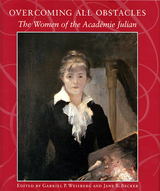 Overcoming All Obstacles: The Women of the Académie Julian
Becker, Jane R
Rutgers University Press, 1999 Overcoming All Obstacles: The Women of the Académie Julian is the first book to examine late nineteenth-century Paris's most famous training ground for the leading women artists of the period. The Académie Julian was founded in Paris in 1868, initially to prepare students for entry to the Ecole des Beaux-Arts, the nineteenth-century's preeminent art school. Because women could not study at the Ecole des Beaux-Arts until 1897, Julian itself became an international equivalent for many of the late nineteenth- and early twentieth-century's most important women artists. Not only does Overcoming All Obstacles introduce the reader to many works by women artists-both famous and lesser known-but the essays offer a cultural and historical context in which to appreciate their art. Gabriel Weisberg's essay concentrates on the rigorous training methods enforced by Rodolphe Julian and the teachers at the Academy. Jane Becker explores the competitive environment of the Julian Academy as it affected the Ukrainian painter Marie Bashkirtseff and the Swiss painter Louise-Catherine Breslau. Essays by Catherine Fehrer, the leading scholar of the Académie Julian, and Tamar Garb, an art historian who focuses on the training of women artists, give us a richer understanding of the Académie Julian's place in the sphere of art education in late nineteenth-century Paris. Generously illustrated with both color and black-and-white images, this volume includes documentary photographs and caricatures that have never before been reproduced. The core of the book draws on the large collection of the Académie Julian Del Debbio, the Académie Julian's successor institution in Paris. This publication accompanied an exhibition organized by the Dahesh Museum in New York that opened after its exhibition at the Sterling and Francine Clark Art Institute in Williamstown. The exhibition subsequently continued to the Dixon Gallery and Gardens, Memphis.
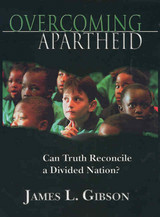 Overcoming Apartheid: Can Truth Reconcile a Divided Nation?
James L. Gibson
Russell Sage Foundation, 2004 Perhaps no country in history has so directly and thoroughly confronted its past in an effort to shape its future as has South Africa. Working from the belief that understanding the past will help build a more peaceful and democratic future, South Africa has made a concerted, institutionalized effort to come to grips with its history of apartheid through its Truth and Reconciliation Commission. In Overcoming Apartheid, James L. Gibson provides the first systematic assessment of whether South Africa's truth and reconciliation process has been successful. Has the process allowed South Africa to let go of its painful past and move on? Or has it exacerbated racial tensions by revisiting painful human rights violations and granting amnesty to their perpetrators? Overcoming Apartheid reports on the largest and most comprehensive study of post-apartheid attitudes in South Africa to date, involving a representative sample of all major racial, ethnic, and linguistic groups. Grounding his analysis of truth in theories of collective memory, Gibson discovers that the process has been most successful in creating a common understanding of the nature of apartheid. His analysis then demonstrates how this common understanding is helping to foster reconciliation, as defined by the acceptance of basic principles of human rights and political tolerance, rejection of racial prejudice, and acceptance of the institutions of a new political order. Gibson identifies key elements in the process—such as acknowledging shared responsibility for atrocities of the past—that are essential if reconciliation is to move forward. He concludes that without the truth and reconciliation process, the prospects for a reconciled, democratic South Africa would diminish considerably. Gibson also speculates about whether the South African experience provides any lessons for other countries around the globe trying to overcome their repressive pasts. A groundbreaking work of social science research, Overcoming Apartheid is also a primer for utilizing innovative conceptual and methodological tools in analyzing truth processes throughout the world. It is sure to be a valuable resource for political scientists, social scientists, group relations theorists, and students of transitional justice and human rights.
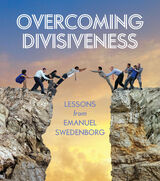 Overcoming Divisiveness: Lessons from Emanuel Swedenborg
Emanuel Swedenborg
Swedenborg Foundation Publishers, 2021 As long as there have been groups of people, there have been divisions between them personal, ideological, racial, religious, ethnic, and more. The ideological divisions in society, particularly those in American society, have been the subject of a lot of discussion in recent years, and at times the divide between the various camps seems insurmountable.
If you’ve been troubled by the broader divides in society, or if there’s a conflict within your own life that’s been a source of pain and anxiety, some spiritually focused thoughts on how to create harmony between those opposing sides may be just what you need. But be warned: as Emanuel Swedenborg tells us, the first step to overcoming a conflict is to look within yourself.
Overcoming Divisiveness contains passages from Swedenborg’s works that give not only insights into the roots of interpersonal conflicts but also perspectives on how to overcome them. Each chapter begins with a brief introduction to a group of related passages. Following each passage, you’ll find the core idea expressed in that passage along with a short description of what it entails, as well as questions for discussion or reflection that are intended to help illustrate how that concept can be directly and meaningfully applied to daily life. You are invited to read the passages from Swedenborg when you need inspiration, use the quotes and reflections as a starting point for a group discussion, or simply enjoy the material as food for your own spiritual journey. You might also find the passages to be inspiration for your own prayers, meditations, creative works, or other techniques for connecting with the Divine.
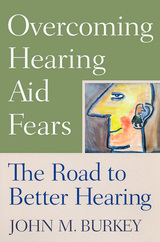 Overcoming Hearing Aid Fears: The Road to Better Hearing
Burkey, John M.
Rutgers University Press, 2003 There are dozens of misconceptions about hearing aids: - “They make you look old.”
- “They cause ear infections.”
- “They increase hearing loss.”
- “I can’t afford one.”
This misinformation impairs a person’s quality of life by discouraging them from pursuing help. Technological advances have enabled hearing aids to address a greater range of hearing losses, while making them smaller, better designed, and easier to use than those of the past. More people than ever can benefit from a hearing aid, yet of the nearly thirty million people with a hearing impairment, only about 20 percent choose to use one. In Overcoming Hearing Aid Fears, audiologist John M. Burkey addresses common fears, concerns, and misconceptions about hearing aids to help readers decide whether these devices will prove useful. Using an informal, anecdotal style informed by years of clinical practice, Burkey provides practical information about hearing aid styles, options, and costs. His expertise and experience in caring for more than 50,000 patients will help people with hearing loss address their personal concerns. The book also helps friends and family understand why a loved one might resist getting a hearing aid, and offers tips on counseling. Audiologists will find this text an important educational tool in advising their own patients. Approximately 10 percent of Americans (and nearly one-third of people age seventy and older) have some degree of hearing loss that, if left untreated, causes frustration, isolation, and depression. A hearing aid is a simple tool to improve careers, relationships, and self-esteem, and to provide independence and security. Overcoming Hearing Aid Fears can help readers take that first step to a better life.
 Overcoming Law
Richard A. Posner
Harvard University Press, 1995 Legal theory must become more factual and empirical and less conceptual and polemical, Richard Posner argues in this wide-ranging new book. The topics covered include the structure and behavior of the legal profession; constitutional theory; gender, sex, and race theories; interdisciplinary approaches to law; the nature of legal reasoning; and legal pragmatism. Posner analyzes, in witty and passionate prose, schools of thought as different as social constructionism and institutional economics, and scholars and judges as different as Bruce Ackerman, Robert Bork, Ronald Dworkin, Catharine MacKinnon, Richard Rorty, and Patricia Williams. He also engages challenging issues in legal theory that range from the motivations and behavior of judges and the role of rhetoric and analogy in law to the rationale for privacy and blackmail law and the regulation of employment contracts. Although written by a sitting judge, the book does not avoid controversy; it contains frank appraisals of radical feminist and race theories, the behavior of the German and British judiciaries in wartime, and the excesses of social constructionist theories of sexual behavior.
Throughout, the book is unified by Posner's distinctive stance, which is pragmatist in philosophy, economic in methodology, and liberal (in the sense of John Stuart Mill's liberalism) in politics. Brilliantly written, eschewing jargon and technicalities, it will make a major contribution to the debate about the role of law in our society.
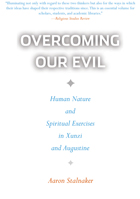 Overcoming Our Evil: Human Nature and Spiritual Exercises in Xunzi and Augustine
Aaron Stalnaker
Georgetown University Press, 2007 Can people ever really change? Do they ever become more ethical, and if so, how? Overcoming Our Evil focuses on the way ethical and religious commitments are conceived and nurtured through the methodical practices that Pierre Hadot has called "spiritual exercises." These practices engage thought, imagination, and sensibility, and have a significant ethical component, yet aim for a broader transformation of the whole personality. Going beyond recent philosophical and historical work that has focused on ancient Greco-Roman philosophy, Stalnaker broadens ethical inquiry into spiritual exercises by examining East Asian as well as classical Christian sources, and taking religious and seemingly "aesthetic" practices such as prayer, ritual, and music more seriously as objects of study. More specifically, Overcoming Our Evil examines and compares the thought and practice of the early Christian Augustine of Hippo, and the early Confucian Xunzi. Both have sophisticated and insightful accounts of spiritual exercises, and both make such ethical work central to their religious thought and practice. Yet to understand the two thinkers' recommendations for cultivating virtue we must first understand some important differences. Here Stalnaker disentangles the competing aspects of Augustine and Xunxi's ideas of "human nature." His groundbreaking comparison of their ethical vocabularies also drives a substantive analysis of fundamental issues in moral psychology, especially regarding emotion and the complex idea of "the will," to examine how our dispositions to feel, think, and act might be slowly transformed over time. The comparison meticulously constructs vivid portraits of both thinkers demonstrating where they connect and where they diverge, making the case that both have been misunderstood and misinterpreted. In throwing light on these seemingly disparate ancient figures in unexpected ways, Stalnaker redirects recent debate regarding practices of personal formation, and more clearly exposes the intellectual and political issues involved in the retrieval of "classic" ethical sources in diverse contemporary societies, illuminating a path toward a contemporary understanding of difference.
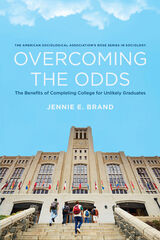 Overcoming the Odds: The Benefits of Completing College for Unlikely Graduates
Jennie E. Brand
Russell Sage Foundation, 2023 Each year, millions of high school students consider whether to continue their schooling and attend and complete college. Despite evidence showing that a college degree yields far-reaching benefits, critics of higher education increasingly argue that college “does not pay off” and some students - namely, disadvantaged prospective college goers - would be better served by forgoing higher education. But debates about the value of college often fail to carefully consider what is required to speak knowledgeably about the benefits –what a person’s life might look like had they not completed college, or their college counterfactual. In Overcoming the Odds sociologist Jennie E. Brand reveals the benefits of completing college by comparing life outcomes of college graduates with their college counterfactuals.
Drawing on two cohorts of nationally representative data from the Bureau of Labor Statistics National Longitudinal Surveys program, Brand uses matching and machine learning methods to estimate the effects of college completion across students with varying likelihoods of completing four-year degrees. To illustrate her findings, Brand describes outcomes using matched vignettes of college and non-college graduates. Brand shows that four-year college completion enables graduates to increase wages and household income, while also circumventing unemployment, low-wage work, job instability, poverty, and social assistance. Completing college also increases civic engagement. Most of these benefits are larger for disadvantaged than for more advantaged students, rendering arguments that college has limited benefits for unlikely graduates as flawed. Brand concludes that greater long-term earnings, and less job instability and unemployment, and thus more tax revenue, less reliance on public assistance, and high levels of volunteering indicate that public investment in higher education for students from disadvantaged backgrounds yields far-reaching collective benefits. She asserts that it is better for our society when more people complete college.
Overcoming the Odds is an innovative and enlightening exploration of how college can transform lives.
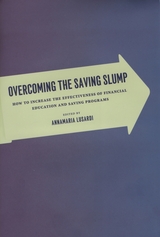 Overcoming the Saving Slump: How to Increase the Effectiveness of Financial Education and Saving Programs
Edited by Annamaria Lusardi
University of Chicago Press, 2009 The great majority of working Americans are unprepared to face the difficult task of planning for retirement. In fact, the personal savings rate has been holding steady at zero for several years, down from 8 percent in the mid-1980s. Overcoming the Saving Slump explores the many challenges facing workers in the transition from a traditional defined benefit pension system to one that requires more individual responsibility, analyzing the considerable impediments to saving and evaluating financial literacy programs devised by employers and the government. Mapping the changing landscape of pensions and the rise of defined contribution plans, Annamaria Lusardi and others investigate new methods for stimulating saving and promoting financial education drawing on the experience of the United States as well as countries that have privatized their welfare systems, including Sweden and Chile. This timely volume pinpoints where human resources departments, the financial industry, and government officials have succeeded—or failed—in bridging the way to a new retirement system. As the workforce ages and more pensions disappear each second, Lusardi’s findings will be invaluable for economists and anyone facing retirement.
Overcoming Zionism: Creating a Single Democratic State in Israel/Palestine
Joel Kovel
Pluto Press, 2007 Joel Kovel argues that the inner contradictions of Zionism have led Israel to a ‘state-sponsored racism’ fully as incorrigible as that of apartheid South Africa and deserving of the same resolution. Only a path toward a single-state secular democracy can provide the justice essential to healing the wounds of the Middle East.
Kovel is well-known writer on the Middle East conflict. This book draws on his detailed knowledge to show that Zionism and democracy are essentially incompatible. He offers a thoughtful account of the emergence and disintegration of Zionism that integrates psychological, political, cultural, economic, and ideological levels.
Ultimately, Kovel argues, a two-state solution is essentially hopeless as it concedes too much to the regressive forces of nationalism, wherein lie the roots of continued conflict.
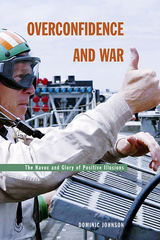 Overconfidence and War: The Havoc and Glory of Positive Illusions
Dominic D. P. Johnson
Harvard University Press, 2004 Opponents rarely go to war without thinking they can win--and clearly, one side must be wrong. This conundrum lies at the heart of the so-called "war puzzle": rational states should agree on their differences in power and thus not fight. But as Dominic Johnson argues in Overconfidence and War, states are no more rational than people, who are susceptible to exaggerated ideas of their own virtue, of their ability to control events, and of the future. By looking at this bias--called "positive illusions"--as it figures in evolutionary biology, psychology, and the politics of international conflict, this book offers compelling insights into why states wage war.
Johnson traces the effects of positive illusions on four turning points in twentieth-century history: two that erupted into war (World War I and Vietnam); and two that did not (the Munich crisis and the Cuban missile crisis). Examining the two wars, he shows how positive illusions have filtered into politics, causing leaders to overestimate themselves and underestimate their adversaries--and to resort to violence to settle a conflict against unreasonable odds. In the Munich and Cuban missile crises, he shows how lessening positive illusions may allow leaders to pursue peaceful solutions.
The human tendency toward overconfidence may have been favored by natural selection throughout our evolutionary history because of the advantages it conferred--heightening combat performance or improving one's ability to bluff an opponent. And yet, as this book suggests--and as the recent conflict in Iraq bears out--in the modern world the consequences of this evolutionary legacy are potentially deadly.
Overcrowded World?: Global Population and International Migration
Rainer Münz
Haus Publishing, 2009 Today our planet is home to 6.8 billion people. By the year 2050, the global population will have grown to 9 billion. Yet the problems that will come with this massive expansion are not universal. Many developing nations will experience high demographic growth, while industrialized countries will have to deal with aging and eventually shrinking populations, as well as with more immigration. Overcrowded World? Global Population and International Migration offers a perspective on the causes and effects of rapid population change, and asks two vital questions: how can Earth sustain this growth? And what can we do to improve the living conditions of present and future generations?
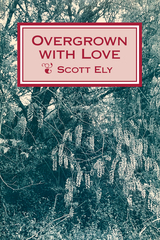 Overgrown with Love
Scott Ely
University of Arkansas Press, 1993 Lead short story featured in 1993 Best American Short Stories A wide variety of characters saunter, stalk, run, and sometimes hide in these lively stories about contemporary Southerners. Their experiences revolve around the way life is felt and the way it is lived, reflecting a gap between the plans we make for ourselves and the way things actually turn out. From the jungles of Vietnam to the bayous of Louisiana, from the French countryside to Vicksburg, Mississippi, Ely’s stories reveal how human beings’ unpredictable, unconscious motivations will have their say no matter what steps are taken to silence them. Certain shadows fall over all the characters—especially the shadows of the Vietnam experience and the struggle between a traditional Southern heritage and the conflicting ideals of contemporary society. The characters in Ely’s stories seem powerless to defend themselves against the ever-changing expectations of a modern life, and yet they gain a new humanity and depth when, with dignity, they embrace their limitations.
Overhead Electric Power Lines: Theory and practice
Surajit Chattopadhyay
The Institution of Engineering and Technology, 2021 In order to fulfill the tremendous worldwide demand for electrification, power line professionals will need to adopt rapid, reliable and sustainable solutions. For example, in a fast-developing country like India, which had the largest population without electricity in 2014 and 1.34 billion inhabitants in 2017, the demand for electrification is immense. In recent years, a new program facilitated 0.73 million new household connections per month and almost 19,000 villages per year.
 Overheard
Dominik Barta, Translated by Gary Schmidt
University of Wisconsin Press, 2025 In his early thirties, Kurt Endlicher has finally settled down, with a steady job as a teacher and a small flat to call his own. But the walls are thin, and he and his neighbors can overhear every cough, footstep, and toilet flush. Initially annoyed by the intimacy, he gradually learns to appreciate the value of community and discovers the key to his own happiness.
Overheard is set in Vienna in the mid-2010s, a time of significant social change and political conflict, with tens of thousands of Middle Eastern refugees arriving and protests taking place over a café’s expulsion of two women who greeted each other with a kiss. Kurt is gay, but his best friend is not. He’s a sympathetic listener, leading him—and the reader—to revisit and reevaluate assumptions.
Originally published as Tür an Tür, Dominik Barta’s novel is a page-turner filled with humor, insight, and a suspenseful plot. Overheard combines visions of an idealized past and a longed-for future to create a present that we all want to inhabit.
Overheating: An Anthropology of Accelerated Change
Thomas Hylland Eriksen
Pluto Press, 2016 We live in a time of global crisis—or, more appropriately, crises: overlapping, interlocking global problems that are inextricably tied to modernity. Overheating offers a groundbreaking new way of looking at the problems of the Anthropocene, exploring crises of the environment, economy, and identity through an anthropological lens. Thomas Hylland Eriksen argues that while each of these crises is global in scope, they are nonetheless perceived and responded to locally—and that once we realize that, we begin to see the contradictions that abound between the standardizing forces of global capitalism and the socially embedded nature of people and local practices. Only by acknowledging the primacy of the local, Eriksen shows, can we begin to even properly understand, let alone address, these problems on a global scale.
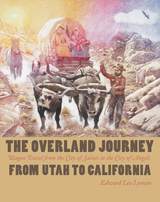 The Overland Journey From Utah To California: Wagon Travel From The City Of Saints To The City Of Angels
Edward Leo Lyman
University of Nevada Press, 2008 The wagon trail between Salt Lake City and Los Angeles is one of the most important and least-known elements of nineteenth-century Western migration. Known as the Southern Route, it included the western half of the Old Spanish Trail and was favored because it could be used for travel and freighting year-round. It was, however, likely the most difficult route that pioneers traveled with any consistency, following not rivers but leading from one--sometimes dubious--desert watering place to the next and offering few havens for the sick, weary, or unfortunate. Historian Edward Leo Lyman has provided the first history of the complete Southern Route and of the people who developed and used it. Based on extensive research in primary sources--including many early travelers’ accounts--and on Lyman’s own investigation of the route and its branches, the book discusses the exploration and development of the Old Spanish Trail, its horse thieves and traders, including Jed Smith and Kit Carson, along with government explorere John C. Frémont. Developing the old pack mule trail as a wagon road between Salt Lake City and Los Angeles, miners heading for the California gold fields first used the route extensively. Mormon missionaries and the colonizers of San Bernardino and other communities also traveled that way, as did a wide array of mail carriers, soldiers and world travelers. Later, a steady stream of Anglo-American emigrants seeking new homes or fortunes in California shared the road with a surprising number of freight wagon operators. The trail passed through the territories of numerous Native American peoples, and contacts with them--both friendly and hostile--played a significant role in the experiences of travelers and in the fates of Native American cultures in this region. Lyman’s discussions of Mormon-Indian relations and of the infamous Mountain Meadows Massacre offer fresh and important analyses of these vital aspects of the westward movement.
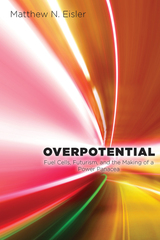 Overpotential: Fuel Cells, Futurism, and the Making of a Power Panacea
Eisler, Matthew
Rutgers University Press, 2012 It sounds so simple. Just combine oxygen and hydrogen in an electrochemical reaction that produces water and electricity, and you’ll have a clean, efficient power source. But scientists have spent decades—and billions of dollars in government and industry funding—developing the fuel cell. There have been successes and serendipitous discoveries along the way, but engineering a fuel cell that is both durable and affordable has proved extraordinarily difficult. Overpotential charts the twists and turns in the ongoing quest to create the perfect fuel cell. By exploring the gap between the theory and practice of fuel cell power, Matthew N. Eisler opens a window into broader issues in the history of science, technology, and society after the Second World War, including the sociology of laboratory life, the relationship between academe, industry, and government in developing advanced technologies, the role of technology in environmental and pollution politics, and the rise of utopian discourse in science and engineering.
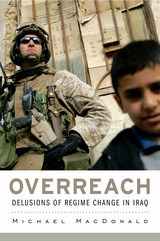 Overreach: Delusions of Regime Change in Iraq
Michael MacDonald
Harvard University Press, 2014 In the run-up to the 2003 invasion of Iraq, a fair number of Americans thought the idea was crazy. Now everyone, except a few die-hards, thinks it was. So what was going through the minds of the talented and experienced men and women who planned and initiated the war? What were their assumptions? Overreach aims to recover those presuppositions.
Michael MacDonald examines the standard hypotheses for the decision to attack, showing them to be either wrong or of secondary importance: the personality of President George W. Bush, including his relationship with his father; Republican electoral considerations; the oil lobby; the Israeli lobby. He also undermines the argument that the war failed because of the Bush administration’s incompetence.
The more fundamental reasons for the Iraq War and its failure, MacDonald argues, are located in basic axioms of American foreign policy, which equate America’s ideals with its interests (distorting both in the process) and project those ideals as universally applicable. Believing that democratic principles would bring order to Iraq naturally and spontaneously, regardless of the region’s history and culture or what Iraqis themselves wanted, neoconservative thinkers, with support from many on the left, advocated breaking the back of state power under Saddam Hussein. They maintained that by bringing about radical regime change, the United States was promoting liberalism, capitalism, and democracy in Iraq. But what it did instead was unleash chaos.
Overripe Economy: American Capitalism and the Crisis of Democracy
Alan Nasser
Pluto Press, 2018 Capitalism is in crisis. Overripe Economy uses a historical view to explain how we got here and why. Taking readers through the history of American capitalism--from the ruthless competition of the nineteenth century to the maturation of industrial capitalism in the early part of the twentieth and on into today’s finance-ridden decline--Alan Nasser lays out here in damning detail why the persistent austerity of financialized capitalism is the inevitable outcome of the evolution of the American economy. Capitalism, he argues, ultimately presents us with two alternatives: persistent austerity, declining democracy, and a privatized state, or a polity and economy characterized by genuine economic democracy.
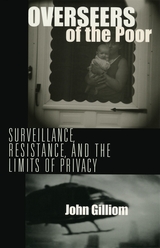 Overseers of the Poor: Surveillance, Resistance, and the Limits of Privacy
John Gilliom
University of Chicago Press, 2001 In Overseers of the Poor, John Gilliom confronts the everyday politics of surveillance by exploring the worlds and words of those who know it best-the watched. Arguing that the current public conversation about surveillance and privacy rights is rife with political and conceptual failings, Gilliom goes beyond the critics and analysts to add fresh voices, insights, and perspectives.
This powerful book lets us in on the conversations of low-income mothers from Appalachian Ohio as they talk about the welfare bureaucracy and its remarkably advanced surveillance system. In their struggle to care for their families, these women are monitored and assessed through a vast network of supercomputers, caseworkers, fraud control agents, and even grocers and neighbors.
In-depth interviews show that these women focus less on the right to privacy than on a critique of surveillance that lays bare the personal and political conflicts with which they live. And, while they have little interest in conventional forms of politics, we see widespread patterns of everyday resistance as they subvert the surveillance regime when they feel it prevents them from being good parents. Ultimately, Overseers of the Poor demonstrates the need to reconceive not just our understanding of the surveillance-privacy debate but also the broader realms of language, participation, and the politics of rights.
We all know that our lives are being watched more than ever before. As we struggle to understand and confront this new order, Gilliom argues, we need to spend less time talking about privacy rights, legislatures, and courts of law and more time talking about power, domination, and the ongoing struggles of everyday people.
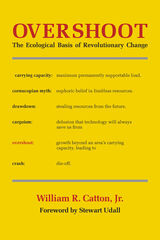 Overshoot: The Ecological Basis of Revolutionary Change
William R. Catton, Jr.
University of Illinois Press, 1980 Our day-to-day experiences over the past decade have taught us that there must be limits to our tremendous appetite for energy, natural resources, and consumer goods. Even utility and oil companies now promote conservation in the face of demands for dwindling energy reserves. And for years some biologists have warned us of the direct correlation between scarcity and population growth. These scientists see an appalling future riding the tidal wave of a worldwide growth of population and technology. A calm but unflinching realist, Catton suggests that we cannot stop this wave - for we have already overshot the Earth's capacity to support so huge a load. He contradicts those scientists, engineers, and technocrats who continue to write optimistically about energy alternatives. Catton asserts that the technological panaceas proposed by those who would harvest from the seas, harness the winds, and farm the deserts are ignoring the fundamental premise that "the principals of ecology apply to all living things." These principles tell us that, within a finite system, economic expansion is not irreversible and population growth cannot continue indefinitely. If we disregard these facts, our sagging American Dream will soon shatter completely.
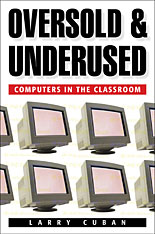 Oversold and Underused: Computers in the Classroom
Larry Cuban
Harvard University Press, 2001 Impelled by a demand for increasing American strength in the new global economy, many educators, public officials, business leaders, and parents argue that school computers and Internet access will improve academic learning and prepare students for an information-based workplace.
But just how valid is this argument? In Oversold and Underused, one of the most respected voices in American education argues that when teachers are not given a say in how the technology might reshape schools, computers are merely souped-up typewriters and classrooms continue to run much as they did a generation ago. In his studies of early childhood, high school, and university classrooms in Silicon Valley, Larry Cuban found that students and teachers use the new technologies far less in the classroom than they do at home, and that teachers who use computers for instruction do so infrequently and unimaginatively.
Cuban points out that historical and organizational economic contexts influence how teachers use technical innovations. Computers can be useful when teachers sufficiently understand the technology themselves, believe it will enhance learning, and have the power to shape their own curricula. But these conditions can't be met without a broader and deeper commitment to public education beyond preparing workers. More attention, Cuban says, needs to be paid to the civic and social goals of schooling, goals that make the question of how many computers are in classrooms trivial.
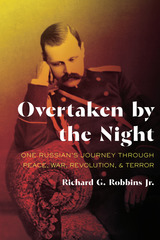 Overtaken by the Night: One Russian's Journey through Peace, War, Revolution, and Terror
Richard G. Robbins Jr.
University of Pittsburgh Press, 2017 Vladimir Fedorovich Dzhunkovsky was a witness to Russia’s unfolding tragedy—from Tsar Alexander II’s Great Reforms, through world war, revolution, the rise of a new regime, and finally, his country’s descent into terror under Stalin. But Dzhunkovsky was not just a passive observer—he was an active participant in his troubled and turbulent times, often struggling against the tide. In the centennial of the Russian revolution, his story takes on special significance.
Highly readable, Overtaken by the Night captivates on many levels. It is a gripping biography of a man of many faces, a behind-the-curtain look at the inner workings of Russian politics at its highest levels, and also an engrossing account of ordinary Russians engulfed by swiftly moving political and social currents.
Dzhunkovsky served as a confidant in the tsar’s imperial court and as governor in Moscow province during and after the 1905 revolution. In 1913 he became the empire’s security chief, determined to reform the practices of the dreaded tsarist political police, the Okhrana. Dismissed from office for daring to investigate and warn Tsar Nicholas about Rasputin, his path led him into combat on the battlefields of the First World War. A natural leader of men, he held his units together even as revolution spilled into the trenches. Arrested as a counterrevolutionary in 1918 and imprisoned until 1921, Dzhunkovsky avoided execution thanks to an outpouring of public support and his reputation for treating revolutionaries with fairness and dignity. Although later he consulted for the Stalinist secret police, he was tried and executed in 1938 as an enemy of the people.
Based on Dzhunkovsky’s detailed memoirs and extensive archival research, Overtaken by the Night paints a fascinating picture of an important figure. Dzhunkovsky's incredible life reveals much about a long and crucial period in Russian history. It is a story of Russia in revolution reminiscent of the fictional Doctor Zhivago, but perhaps even more extraordinary for being true.
Overtapped Oasis: Reform Or Revolution For Western Water
Marc Reisner and Sarah F. Bates
Island Press, 1990 Overtapped Oasis analyzes the West's water allocation system from top to bottom and offers dozens of revolutionary proposals for increased efficiency and policy reform. Marc Reisner and Sarah Bates argue that the West's underlying problem is not a shortage of water but the inefficient use of it, a problem caused by a bewildering tangle of federal subsidy programs, restrictive state water codes, anachronistic irrigation practices and -- perhaps most important -- resistance to reform.
The Overthrow of Allende and the Politics of Chile, 1964-1976
Paul E. Sigmund
University of Pittsburgh Press, 1978 Paul Sigmund, who has studied Chile for more than a decade, and lived and taught there, offers an exhaustive, balanced analysis of the overthrow of Salvador Allende, and why it occurred. Sigmund examines the Allende government, the Frei government that preceeded it, the coup that ended it, and the Pinochet government that succeeded it. He also views the roles of various Chilean political and interest groups, the CIA, and U.S. corporations.
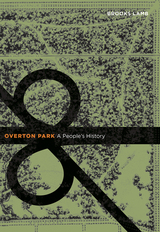 Overton Park: A People's History
Brooks Lamb
University of Tennessee Press, 2018 At the heart of Memphis lies Overton Park, a 342-acre public space that contains the world-class Memphis Zoo, an old-growth forest, the Memphis College of Art, an amphitheater, and the Memphis Brooks Museum of Art, among other beloved amenities. Founded in 1901, the park has been at the center of both celebration and controversy. Performers like Elvis Presley and Johnny Cash have dazzled audiences there, while local children have long enjoyed its playgrounds and runners its jogging trails. During the civil rights era, desegregating the park became a major goal of local activists, and the park’s Greensward was the scene of protests against the Vietnam War. Late in the 1960s and throughout the 1970s, when the proposed route of Interstate 40 threatened the park, concerned citizens banded together to fight the plan—a struggle that reached the Supreme Court and eventually saved the park for future generations.
This delightfully informative book, filled with historic photos, offers a history of the park from the perspective of those who lived it. Brooks Lamb interviewed nearly a score of Memphians—from civil rights activist Johnnie Turner to U.S. Congressman Steve Cohen, from artist Martha Kelly to retired zookeepers Kathy Fay and Richard Meek—to learn what the park has meant to them and to discover the transformations they have witnessed. The stories they tell reveal a dynamic place that remains, despite changes and challenges, a people’s park and, in the words of one resident, “the heartbeat of Memphis.”
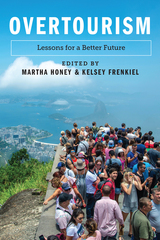 Overtourism: Lessons for a Better Future
Edited by Martha Honey and Kelsey Frenkiel
Island Press, 2021 Before COVID-19 hit, the biggest problem in the world of travel was overtourism. Crowds threatened to spoil natural environments and make daily life unbearable for residents of popular travel destinations. Then, seemingly overnight, tourism nearly ceased. Yet there is no question that travel will resume; the only question is, when it does, what will it look like? Will we return to a world of overrun monuments, littered beaches, and gridlocked city streets? Or can we do things differently this time?
Overtourism: Lessons for a Better Future charts a path toward tourism that is truly sustainable, focusing on the triple bottom line of people, planet, and prosperity. Bringing together tourism officials, city council members, travel journalists, consultants, scholars, and trade association members, this practical book explores overcrowding from a variety of perspectives. After examining the causes and effects of overtourism, it turns to management approaches in five distinct types of tourism destinations:
1. historic cities;
2. national parks and protected areas;
3. World Heritage Sites;
4. beaches and coastal communities; and
5. destinations governed by regional and national authorities.
While each location presents its own challenges, common mitigation strategies are emerging. Visitor education, traffic planning, and redirection to lesser-known sites are among the measures that can protect the economic benefit of tourism without overwhelming local communities.
As tourism revives around the world, these innovations will guide government agencies, parks officials, site managers, civic groups, environmental NGOs, tourism operators, and others with a stake in protecting our most iconic places.
Overvoltage Protection of Low Voltage Systems
Peter Hasse
The Institution of Engineering and Technology, 2000 This book surveys some of the techniques available to protect low-voltage electrical and electronic equipment and systems from lightning strikes and other power surges. The book examines the basic discharge processes in air and their effects, through transient electromagnetic field generation and interaction with overhead lines and underground cables. Attention is paid to the use of models for lightning protection and the book focuses on protection techniques based on modelled lightning protection zones. This is then logically developed in a major section on the practical components and applications of protective measures and systems, as well as testing techniques. These are placed in the context of current IEC and VDE standards. The book is highly illustrated with a vast number of photographs as well as system diagrams and tabular matter.
Overweight Sensation: The Life and Comedy of Allan Sherman
Mark Cohen
Brandeis University Press, 2013 Allan Sherman was the Larry David, the Adam Sandler, the Sacha Baron Cohen of 1963. He led Jewish humor and sensibilities out of ethnic enclaves and into the American mainstream with explosively funny parodies of classic songs that won Sherman extraordinary success and acclaim across the board, from Harpo Marx to President Kennedy. In Overweight Sensation, Mark Cohen argues persuasively for Sherman’s legacy as a touchstone of postwar humor and a turning point in Jewish American cultural history. With exclusive access to Allan Sherman’s estate, Cohen has written the first biography of the manic, bacchanalian, and hugely creative artist who sold three million albums in just twelve months, yet died in obscurity a decade later at the age of forty-nine. Comprehensive, dramatic, stylish, and tragic, Overweight Sensation is destined to become the definitive Sherman biography.
Overwinter
Jeremy Pataky
University of Alaska Press, 2015 A debut collection from an exciting new voice in Alaska poetry, Overwinter reconciles the natural quiet of wilderness with the clamor of built environments. Jeremy Pataky’s migration between Anchorage and Wrangell-St. Elias National Park inspires these poems that connect urban to rural. This duality permeates Overwinter. Moments are at turns fevered or serene. The familial and romantic are measured against the wildness of the Far North. Empty spaces bring both solace and loneliness in full. Past loves haunt the present, surviving in the spaces sculpted by language.
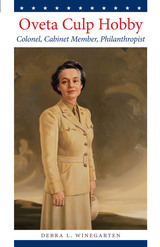 Oveta Culp Hobby: Colonel, Cabinet Member, Philanthropist
By Debra L. Winegarten
University of Texas Press, 2014 This young adult biography introduces middle school readers to a remarkable woman who founded the Women’s Army Corps, served as Secretary of Health, Education, and Welfare, and ran a media empire that included the Houston Post newspaper and radio and TV stations. Winner, Gold Medal for Biography, Military Writers Society of America, 2015 Oveta Culp Hobby (1905–1995) had a lifetime of stellar achievement. During World War II, she was asked to build a women’s army from scratch—and did. Hobby became Director of the Women’s Army Corps and the first Army woman to earn the rank of colonel. President Eisenhower chose her as Secretary of Health, Education, and Welfare, making her the second woman in history to be appointed to a president’s cabinet. When she wasn’t serving in the government, Hobby worked with her husband, former Texas governor William P. Hobby, to lead a media empire that included the Houston Post newspaper and radio and TV stations. She also supported the Houston community in many ways, from advocating for civil rights for African Americans to donating generously to the Houston Symphony and the Museum of Fine Arts. Oveta Culp Hobby is the first biography of this important woman. Written for middle school readers, it traces her life from her childhood in Killeen to her remarkable achievements in Washington, DC, and Houston. Debra Winegarten provides the background to help young adult readers understand the times in which Hobby lived and the challenges she faced as a woman in nontraditional jobs. She shows how Hobby opened doors for women to serve in the military and in other professions that still benefit women today. Most of all, Oveta Culp Hobby will inspire young adults to follow their own dreams and turn them into tangible reality.
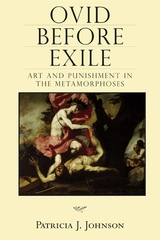 Ovid before Exile: Art and Punishment in the Metamorphoses
Patricia J. Johnson
University of Wisconsin Press, 2007 The epic Metamorphoses, Ovid’s most renowned work, has regained its stature among the masterpieces of great poets such as Vergil, Horace, and Tibullus. Yet its irreverent tone and bold defiance of generic boundaries set the Metamorphoses apart from its contemporaries. Ovid before Exile provides a compelling new reading of the epic, examining the text in light of circumstances surrounding the final years of Augustus’ reign, a time when a culture of poets and patrons was in sharp decline, discouraging and even endangering artistic freedom of expression.
Patricia J. Johnson demonstrates how the production of art—specifically poetry—changed dramatically during the reign of Augustus. By Ovid’s final decade in Rome, the atmosphere for artistic work had transformed, leading to a drop in poetic production of quality. Johnson shows how Ovid, in the episodes of artistic creation that anchor his Metamorphoses, responded to his audience and commented on artistic circumstances in Rome.
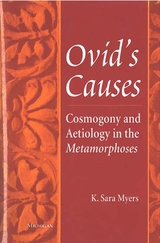 Ovid's Causes: Cosmogony and Aetiology in the Metamorphoses
K. Sara Myers
University of Michigan Press, 1994 Ovid’s Causes offers a new reassessment of the poet’s longest and most difficult poem, the Metamorphoses. This poem has long been denied epic stature because of its stylistic and thematic diversity. K. Sara Myers demonstrates that the poem must be understood as the inheritor and interpreter of the Roman tradition of cosmological epic. She situates the poem in the traditions and conventions of Roman poetry and considers the ways in which it both fulfills and overturns the expectations of the epic genre.
The first and final chapters of this book examine the scientific and cosmological framework of the poem. Ovid’s juxtaposition of scientific and mythological explanations is an aspect of his sophisticated manipulation of truth and fiction, and of the claims of philosophical poetry and mythological poetry.
This illuminating study presents much useful material for students of Roman poetry or of Greek literary influences that profoundly influenced its development. Students and scholars of ancient poetical traditions will likewise find much of interest.
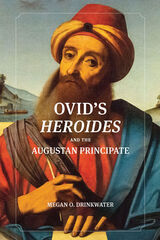 Ovid's "Heroides" and the Augustan Principate
Megan O. Drinkwater
University of Wisconsin Press, 2023 43 BCE, the year after the assassination of Julius Caesar. While the Roman republic had seen many conflicts, it was this civil war, headed by the vengeful triumvirate of Mark Anthony, Marcus Lepidus, and Octavian, that irrevocably transformed Rome with its upheaval. What followed was years of fighting and the eventual ascendancy of Octavian, who from 27 BCE onwards would be best known as Caesar Augustus, founder of the Roman Principate.
It was in this era of turmoil and transformation that Ovid, the Roman poet best known for Metamorphoses, was born. The Heroides, one of his earliest and most elusive works, is not written from the first-person perspective that so often characterizes the elegiac poetry of that time but from the personae of tragic heroines of classical mythology.
Megan O. Drinkwater illustrates how Ovid used innovations of literary form to articulate an expression of the crisis of civic identity in Rome at a time of extreme and permanent political change. The letters are not divorced from the context of their composition but instead elucidate that context for their readers and expose how Ovid engaged in politics throughout his entire career. Their importance is as much historical as literary. Drinkwater makes a compelling case for understanding the Heroides as a testament from one of Rome’s most eloquent writers to the impact that the dramatic shift from republic to empire had on its intellectual elites.
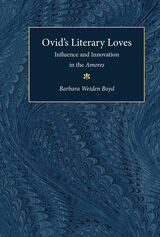 Ovid's Literary Loves: Influence and Innovation in the Amores
Barbara Weiden Boyd
University of Michigan Press, 1997 Ovid's poetry has in recent years enjoyed a remarkable renaissance: in particular, there has been a surge of interest in the Heroides, the Fasti, and his exile poetry. Ovid's Literary Loves, by Barbara Weiden Boyd, reopens the Amores for the modern reader. The volume establishes a context for the recent reception of the Amores, and proposes an alternative approach to the collection by discussing recent trends in the discussion of imitation in Roman poetry. A premise basic to most Ovidian studies has been that the Amores are not only imitative, but parodic, both of the elegiac genre writ large and of Propertius in particular. In contrast, Boyd emphasizes the many nonelegiac, non-Propertian features of the collection. Ovid's irony and its consequences are also discussed with special attention to the narrative structure of the three books.
Boyd's thoughtful approach to imitation in Latin poetry brings into prominence the formative role played by Virgil in shaping Ovid's "poetic memory," even in the Amores. The detailed examination of Ovidian extended similes shows how the poet exploits the literary past precisely in order to free himself from generic restraint and to expand the narrow horizons of elegy. Boyd argues that this paradox is the essence of Ovidian poetics.
Ovid's Literary Loves is an imaginative approach to imitation in Latin poetry and makes a significant contribution to current discussions of the subject. This is one of the first contemporary scholarly monographs on the Amores, and it will find a large and welcoming audience of Latinists at all levels of study.
Barbara Weiden Boyd is Associate Professor of Classics, Bowdoin College, Brunswick, Maine.
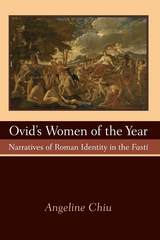 Ovid's Women of the Year: Narratives of Roman Identity in the Fasti
Angeline Chiu
University of Michigan Press, 2016 Roman love-poet Ovid, best known for the epic Metamorphoses, offers in his Fasti the self-proclaimed goal of exploring and explicating the Roman calendar. Published in his maturity circa 14 CE, the Fasti presents claims of aetiological, astronomical, and even antiquarian interests, but more importantly the poem highlights an extraordinary prominence of female characters at work, play, and worship in its verses. From flirtatious goddesses to talkative old women, beautiful puellae to stern prophetesses and beyond, Ovid’s “calendar girls” appear in a vast and kaleidoscopic array of guises and narratives, importing and transforming literary genre and expectation alike in a poem that already in shape and purpose is unique in Latin literature. The poet’s long-standing fascination with female figures that had first appeared in his earliest work and then accompanied him throughout his career now resurfaces in a much more complex form.
Of interest to literary scholars, antiquarians, and those studying the social and political roles of ancient women, Ovid’s Women of the Year offers an intriguing view of an Ovidian poem now coming into its own.
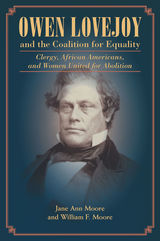 Owen Lovejoy and the Coalition for Equality: Clergy, African Americans, and Women United for Abolition
Jane Ann Moore and William F. Moore
University of Illinois Press, 2019 Antislavery white clergy and their congregations. Radicalized abolitionist women. African Americans committed to ending slavery through constitutional political action. These diverse groups attributed their common vision of a nation free from slavery to strong political and religious values. Owen Lovejoy’s gregarious personality, formidable oratorical talent, probing political analysis, and profound religious convictions made him the powerful leader the coalition needed. Owen Lovejoy and the Coalition for Equality examines how these three distinct groups merged their agendas into a single antislavery, religious, political campaign for equality with Lovejoy at the helm. Combining scholarly biography, historiography, and primary source material, Jane Ann Moore and William F. Moore demonstrate Lovejoy's crucial role in nineteenth-century politics, the rise of antislavery sentiment in religious spaces, and the emerging congressional commitment to end slavery. Their compelling account explores how the immorality of slavery became a touchstone of political and religious action in the United States through the efforts of a synergetic coalition led by an essential abolitionist figure.
Owl Question: Poems
Faith Shearin
Utah State University Press, 2004 Winner of the sixth annual May Swenson Poetry Award, The Owl Question underscores and relishes life's transitions from young girl to woman, from child to wife to mother, and from isolation to connection this poet's bright sense of abundance and awe, here expressed in finely tuned detail and refreshingly open observation, reads like a collective memory. Though private and closely held, these questionings are as familiar as our own souls, and in their transformation to poetry, Shearin has created the very "map" she wishes to guide her when she "can't learn the world fast enough."
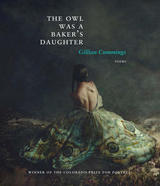 The Owl Was a Baker’s Daughter
Gillian Cummings
University Press of Colorado, 2018 In The Owl Was a Baker’s Daughter, Gillian Cummings gives voice to her version of Ophelia, a young woman shattered by unbearable losses, and questions what makes a mind unwind till the outcome is deemed a suicide. Ophelia’s story, spoken quietly, lyrically, in prose poems whose tone is unapologetically feminine, is bracketed by short, whittled-down once-sonnets featuring other Ophelias, nameless “she” and “you” characters who address the question of madness and its aftermath. These women and girls want to know, what is God when the soul is at its nadir of suffering, and how can one have faith when living with a mind that wants to destroy itself?
If it is true, as Joseph Campbell said, that “the psychotic drowns in the same waters in which the mystic swims with delight,” then Cummings strains the boundaries of this notion: “Is it the same? The desire to end a life / and the need to know how: a flower’s simple bliss?” Her women and girls, part “little heavenling” and part “small hellborn,” understand the emptiness of utmost despair and long for that other emptiness, which can be thought of as union with God, the death of the troublesome ego. Cummings’s poetic ancestors may be Dickinson and Plath and her source here Shakespeare, but more contemporary voices also echo in her poems, those of Lucie Brock-Broido, Larissa Szporluk, and Cynthia Cruz. Here, in The Owl Was a Baker’s Daughter, is what might happen if, after sealing off the doors and turning on the gas, indeed, after dying, a poet had come to embrace the holiness in how “all dissolves: one color, / one moon, all earth, red as love, red as living.”
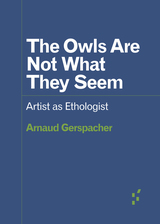 The Owls Are Not What They Seem: Artist as Ethologist
Arnaud Gerspacher
University of Minnesota Press, 2022 Toward a posthumanist art and ethology
The Owls Are Not What They Seem is a selective history of modern and contemporary engagements with animals in the visual arts and how these explorations relate to the evolution of scientific knowledge regarding animals. Arnaud Gerspacher argues that artistic knowledge, with its experimental nature, ability to contain contradictions, and more capacious understanding of truth-claims, presents a valuable supplement to scientific knowledge when it comes to encountering and existing alongside nonhuman animals and life worlds. Though critical of art works involving animals that are unreflective and exploitative, Gerspacher’s exploration of aesthetic practices by Allora & Calzadilla, Pierre Huyghe, Agnieszka Kurant, Araya Rasdjarmrearnsook, Martin Roth, David Weber-Krebs, and others suggests that, alongside scientific practices, art has much to offer in revealing the otherworldly qualities of animals and forging ecopolitical solidarities with fellow earthlings.
Owls, Caves and Fossils: Predation, Preservation and Accumulation of Small Mammal Bones in Caves, with an Analysis of the Pleistocene Cave Faunas From Westbury-Sub-Mendip, Somerset, U.K.
Peter Andrews
University of Chicago Press, 1990 Owls, Caves, and Fossils is the first comprehensive, fully illustrated account of small mammal taphonomy. The study of small mammal remains has previously been neglected in favor of such large mammals as elephants, bovids, and carnivores, and Andrews remedies this deficiency by analyzing the taphonomic processes significant in the preservation of small mammal fauna in caves.
 The Owners of Kinship: Asymmetrical Relations in Indigenous Amazonia
Luiz Costa
HAU, 2017 The Owners of Kinship investigates how kinship in Indigenous Amazonia is derived from the asymmetrical relation between an “owner” and his or her dependents. Through a comprehensive ethnography of the Kanamari, Luiz Costa shows how this relationship is centered around the bond created between the feeder and the fed.
Building on anthropological studies of the acquisition, distribution, and consumption of food and its role in establishing relations of asymmetrical mutuality and kinship, this book breaks theoretical ground for studies in Amazonia and beyond. By investigating how the feeding relation traverses Kanamari society—from the relation between women and the pets they raise, shaman and familiar spirit, mother and child, chiefs and followers, to those between the Brazilian state and the Kanamari—The Owners of Kinship reveals how the mutuality of kinship is determined by the asymmetry of ownership.
Owners of the Sidewalk: Security and Survival in the Informal City
Daniel M. Goldstein
Duke University Press, 2016 Many of Bolivia's poorest and most vulnerable citizens work as vendors in the Cancha mega-market in the city of Cochabamba, where they must navigate systems of informality and illegality in order to survive. In Owners of the Sidewalk Daniel M. Goldstein examines the ways these systems correlate in the marginal spaces of the Latin American city. Collaborating with the Cancha's legal and permanent stall vendors (fijos) and its illegal and itinerant street and sidewalk vendors (ambulantes), Goldstein shows how the state's deliberate neglect and criminalization of the Cancha's poor—a practice common to neoliberal modern cities—makes the poor exploitable, governable, and consigns them to an insecure existence. Goldstein's collaborative and engaged approach to ethnographic field research also opens up critical questions about what ethical scholarship entails.
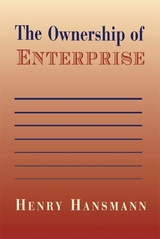 The Ownership of Enterprise
Henry Hansmann
Harvard University Press, 2000 The investor-owned corporation is the conventional form for structuring large-scale enterprise in market economies. But it is not the only one. Even in the United States, noncapitalist firms play a vital role in many sectors. Employee-owned firms have long been prominent in the service professions--law, accounting, investment banking, medicine--and are becoming increasingly important in other industries. The buyout of United Airlines by its employees is the most conspicuous recent instance. Farmer-owned produce cooperatives dominate the market for most basic agricultural commodities. Consumer-owned utilities provide electricity to one out of eight households. Key firms such as MasterCard, Associated Press, and Ace Hardware are service and supply cooperatives owned by local businesses. Occupant-owned condominiums and cooperatives are rapidly displacing investor-owned rental housing. Mutual companies owned by their policyholders sell half of all life insurance and one-quarter of all property and liability insurance. And nonprofit firms, which have no owners at all, account for 90 percent of all nongovernmental schools and colleges, two-thirds of all hospitals, half of all day-care centers, and one-quarter of all nursing homes.
Henry Hansmann explores the reasons for this diverse pattern of ownership. He explains why different industries and different national economies exhibit different distributions of ownership forms. The key to the success of a particular form, he shows, depends on the balance between the costs of contracting in the market and the costs of ownership. And he examines how this balance is affected by history and by the legal and regulatory framework within which firms are organized.
With noncapitalist firms now playing an expanding role in the former socialist countries of Eastern Europe and Asia as well as in the developed market economies of the West, The Ownership of Enterprise will be an important book for business people, policymakers, and scholars.
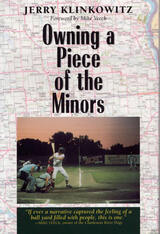 Owning a Piece of the Minors
Jerry Klinkowitz. Foreword by Mike Veeck
Southern Illinois University Press, 1999
Owning a Piece of the Minors is by and about a man who lived his dream and acquired a baseball team. When Jerry Klinkowitz joined the group that ran the Waterloo, Iowa, Diamonds in the 1970s, ownership of a minor league baseball franchise conferred little mystique. Neglected for a half century, minor league baseball was at best obscure. Yet in the purchase of fantasy, what difference if your desire is out of style?
Klinkowitz continued his work with the Diamonds through the 1980s and much of the 1990s. In Owning a Piece of the Minors, he maps out his personal journey through baseball and probes his fluctuating fortunes and those of his team as he evolves from a fan to a team executive and, most important, to a writer writing about baseball. This baseball story begins with a nine-year-old Klinkowitz who is elated when Milwaukee lures the Braves from Boston; this story of a love affair with baseball might have died—and in fact suffered a ten-year hiatus—when the apostate Braves fled to Atlanta in 1965.
Klinkowitz rediscovered the joy of being at the baseball park when, as a middle-aged professor, he took his own children to the Waterloo Diamonds games. Gradually his involvement with the Diamonds grew deeper until he owned the team. His immersion into team activities was complete, from shagging batting practice and working the beer bar to struggling with the Cleveland Indians and then the San Diego Padres as minor league affiliates to accommodate baseball's resurgence.
Klinkowitz writes of loss—first the Braves and later the Diamonds; of writing baseball fiction; of attending the 1982 World Series back in Milwaukee; of the great old ballparks around the country, including Wrigley, Fenway, and old Comiskey Park; of fictional and factual accounts of how the Diamonds franchise was lost; of friendships among season ticket holders in "Box 28"; and of Mildred Boyenga, the club president and Baseball Woman of the Year. A first-rate stylist, Klinkowitz shows the problems and perks and, most rewarding, the priceless relationships made possible in the world of baseball.
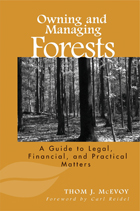 Owning and Managing Forests: A Guide to Legal, Financial, and Practical Matters
Thom J. McEvoy; Foreword by Carl Reidel
Island Press, 2006 Owning and Managing Forests is both an accessible overview of the privileges, rights, and obligations that accompany forest ownership and a guidebook to help active forest owners and managers use laws to their advantage and avoid the pitfalls of expensive and exhausting litigation. The book is a revised, expanded, and updated edition of Legal Aspects of Owning and Managing Woodlands, published in 1998 by Island Press and named Best Forestry Book of the Year by the National Woodland Owners Association.
This edition provides current information on recent changes in property, environmental, and tax laws, while also discussing new directions in forest management. It offers expanded treatment of topics including private property, searching property records, easements, estate planning, timber sale contracts, working with forestry professionals, and how to pass woodlands intact to future generations. The book also describes the many different facets of trusts, changes in forestland taxation methods, and new licensing and certification options. Included, too, is a section on avoiding disputes and how to use alternative dispute resolution methods to avoid costly, troubling, and time-consuming court battles.
Owning and Managing Forests provides clear and concise descriptions of often confusing concepts and difficult subjects, and addresses issues in a competent yet conversational tone. Anyone involved with owning or managing forestland will find the book an essential guide and reference.
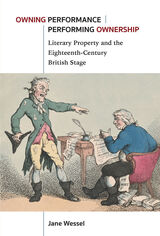 Owning Performance | Performing Ownership: Literary Property and the Eighteenth-Century British Stage
Jane Wessel
University of Michigan Press, 2022 In 1710, England’s first copyright law gave authors the ability to own their works, but it was not until 1833 that literary property law was extended to protect dramatic performance. Between these dates, generations of playwrights grappled for control over their intellectual property in a cultural and legal environment that treated print differently from performance. As ownership became a central concern for many, actors fought to possess their dramatic parts exclusively, playwrights struggled to control and profit from repeat performances of their works, and managers tried to gain a monopoly over the performance of profitable plays. Owning Performance follows the careers of some of the 18th century’s most influential playwrights, actors, and theater managers as they vied for control over the period’s most popular shows. Without protection for dramatic literary property, these figures developed creative extra-legal strategies for controlling the performance of drama—quite literally performing their ownership. Their various strategies resulted in a culture of ephemerality, with many of the period’s most popular works existing only in performance and manuscript copies. Author Jane Wessel explores how playwrights and actors developed strategies for owning their works and how, in turn, theater managers appropriated these strategies, putting constant pressure on artists to innovate. Owning Performance reveals the wide-reaching effects of property law on theatrical culture, tracing a turn away from print that affected the circulation, preservation, and legacy of 18th century drama.
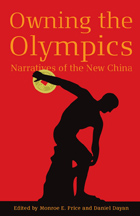 Owning the Olympics: Narratives of the New China
Monroe E. Price and Daniel Dayan, Editors
University of Michigan Press, 2008 "A major contribution to the study of global events in times of global media. Owning the Olympics tests the possibilities and limits of the concept of 'media events' by analyzing the mega-event of the information age: the Beijing Olympics. . . . A good read from cover to cover."
—Guobin Yang, Associate Professor, Asian/Middle Eastern Cultures & Sociology, Barnard College, Columbia University From the moment they were announced, the Beijing Games were a major media event and the focus of intense scrutiny and speculation. In contrast to earlier such events, however, the Beijing Games are also unfolding in a newly volatile global media environment that is no longer monopolized by broadcast media. The dramatic expansion of media outlets and the growth of mobile communications technology have changed the nature of media events, making it significantly more difficult to regulate them or control their meaning. This volatility is reflected in the multiple, well-publicized controversies characterizing the run-up to Beijing 2008. According to many Western commentators, the People's Republic of China seized the Olympics as an opportunity to reinvent itself as the "New China"---a global leader in economics, technology, and environmental issues, with an improving human-rights record. But China's maneuverings have also been hotly contested by diverse global voices, including prominent human-rights advocates, all seeking to displace the official story of the Games. Bringing together a distinguished group of scholars from Chinese studies, human rights, media studies, law, and other fields, Owning the Olympics reveals how multiple entities---including the Chinese Communist Party itself---seek to influence and control the narratives through which the Beijing Games will be understood. digitalculturebooks is an imprint of the University of Michigan Press and the Scholarly Publishing Office of the University of Michigan Library dedicated to publishing innovative and accessible work exploring new media and their impact on society, culture, and scholarly communication. Visit the website at www.digitalculture.org.
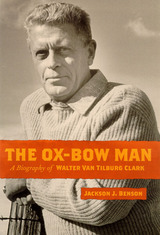 The Ox-Bow Man: A Biography Of Walter Van Tilburg Clark
Jackson J. Benson
University of Nevada Press, 2006 Walter Van Tilburg Clark, author of the classic novel The Ox-Bow Incident, was one of the West’s most important literary figures, a writer who contributed mightily to the tradition of viewing the West realistically and not through the veil of myth and romance. As a comparatively young man, he published three novels and a collection of short stories, then remained almost silent for the rest of his life, the victim of a paralyzing case of writer’s block. Now Jackson J. Benson, one of the country’s foremost literary biographers, has produced the first full-length biography of this brilliant, enigmatic, and ultimately tragic figure. Based on widely scattered sources—personal papers and correspondence; interviews with family members, friends, and others; and Clark’s unpublished stories and poems—Benson’s biography focuses on Clark’s intellectual and literary life as a writer, teacher, and westerner. Benson masterfully balances his engaging account of the experiences, people, and settings of Clark’s life with a penetrating examination of his complex psyche and the crippling perfectionism that virtually ended Clark’s career, as well as offering up a thoughtful assessment of Clark’s place in Western writing. In these pages, Clark lives again, a warm, complex, and ultimately anguished human being. Benson’s remarkably astute and sensitive biography is destined to be the book that readers and researchers consult first for information about this major western writer.
 Oxcart Catholicism Fifth Avenue: Theology
Ana Maria Diaz-Stevens
University of Notre Dame Press, 1993 "This balanced, readable history of Hispanic ministry in New York is perhaps the finest work available on this scale concerning Puerto Rican Catholics on the mainland." -Review for Religious
" ... a valuable book. For its historical perspective alone it deserves to be read and studied in detail by persons who are engaged in the rapidly expanding area of 'Hispanic ministry.' " -Sociology of Religion
"This balanced, readable history of Hispanic ministry in New York is perhaps the finest work available on this scale concerning Puerto Rican Catholics on the mainland. Diaz-Stevens speaks not only as a sociologist, but as a witness to and participant in many of the events she narrates. She deals masterfully with such prominent figures as Felix Valera, Ivan Illich, Robert Fox, Robert Stern, and Joseph Fitzpatrick, without forgetting such discounted heroines as Las Hijas de Maria."-Review for Religious
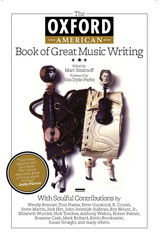 The Oxford American Book of Great Music Writing
Marc Smirnoff
University of Arkansas Press, 2010 Not only have a breathtaking array of musical giants come from the South—think Elvis Presley, Robert Johnson, Louis Armstrong, Jimmie Rodgers, to name just obvious examples—but so have a breathtaking array of American music genres. From blues to rock & roll to jazz to country to bluegrass—and areas in between—it all started in the American South. Since its debut in 1996, The Oxford American's more-or-less annual Southern Music Issue has become legendary for its passionate and wide-ranging approach to music and for working with some of America's greatest writers. These writers—from Peter Guralnick to Nick Tosches to Susan Straight to William Gay—probe the lives and legacies of Southern musicians you may or may not yet be familiar with, but whom you'll love being introduced, or reintroduced, to. In one creative, fresh way or another, these writers also uncover the essence of music—and why music has such power over us.
To celebrate ten years of Southern music issues, most of which are sold-out or very hard to find, the fifty-five essays collected in this dynamic, wide-ranging, and vast anthology appeal to both music fans and fans of great writing.
 Oxford, Bodleian Library, MS. Canon. Misc. 213
Edited by David Fallows
University of Chicago Press, 1995 This volume makes available for the first time in a facsimile edition one of the most important musical manuscripts of the late Middle Ages.
Copied probably in Venice around 1430, the Oxford manuscript contains the most comprehensive surviving collection of secular songs of the late fourteenth and early fifteenth centuries. Of the 326 pieces, 216 are not found in any other source. Including works by Guillaume Dufay, Binchois, and nearly all other leading composers of their generation, it is central to an understanding of fifteenth-century song traditions. Because of the copyist's clear and distinctive hand, it is also significant for studies of late medieval musical notation. David Fallows's introduction includes a history of the manuscript, analysis of its preparation, and survey of its choice of repertory, as well as a full inventory of the music and alphabetical indexes by title and composer. The original-size facsimile includes beta-radiographs of all watermarks, as well as ultraviolet photos that show the copyist's changes and revisions.
This volume is the first edition in a new series called Late Medieval and Early Renaissance Music in Facsimile edited by Margaret Bent and John Nádas and published by the University of Chicago Press. This series will include high-quality reproductions of some of the most important and frequently studied European music manuscripts of the late thirteenth through early fifteenth centuries. Each beautifully produced facsimile edition will include a detailed critical introduction and a complete inventory by an acknowledged expert in the field.
Oxford Botanic Garden & Arboretum: A Brief History
Stephen A. Harris
Bodleian Library Publishing, 2017 The Oxford Botanic Garden is the oldest surviving botanic garden in Britain, occupying the same location in central Oxford since 1621. Designed as a nursery for growing medicinal plants amid the turmoil of the civil war, and nurtured through the restoration of the monarchy, it has, perhaps unsurprisingly, a curious past.
This book tells the story of the garden through accounts of each of its keepers, tracing their work and priorities, from its founding keeper, Jacob Bobart, through to the early nineteenth-century partnership of gardener William Baxter and academic Charles Daubeny, who together gave the garden its greenhouse and ponds and helped ensure its survival to the present. Richly illustrated, this book offers a wonderful introduction to a celebrated Oxford site.
 Oxford Botanic Garden: A Guide
Simon Hiscock and Chris Thorogood
Bodleian Library Publishing, 2019 Oxford Botanic Garden has occupied its central Oxford site next to the river Cherwell continuously since its foundation in 1621 and is the United Kingdom’s oldest botanic garden. Today, the Garden holds a collection of more than five thousand different types of plant, some of which exist nowhere else and are of international conservation importance.
This guide explores Oxford Botanic Garden’s many historic and innovative features, from the walled garden to the waterlily pool, the greenhouses, the rock garden, the water garden and “Lyra’s bench,” made famous in Philip Pullman’s beloved His Dark Materials series. It also gives a detailed explanation of the Garden’s medicinal and taxonomic beds and special plant collections. Lavishly illustrated with specially-commissioned photographs, this book not only provides a fascinating historical overview but also offers a practical guide to Oxford Botanic Garden and its work today. Featuring a map of the site and a historic timeline, this book is a beautiful souvenir of the birthplace of botanical science in the UK.
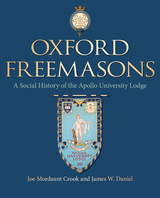 Oxford Freemasons: A Social History of Apollo University Lodge
Joe Mordaunt Crook and James W. Daniel
Bodleian Library Publishing, 2018 Over the past two hundred years, many thousands of undergraduates have been initiated into membership of Apollo, the Masonic Lodge of the University of Oxford. These have included such diverse figures as Oscar Wilde, Samuel Reynolds Hole, and Edward, Prince of Wales and his brother Leopold. Drawing on archives held in the Bodleian Library, this book is the first serious attempt to set the story of Apollo in the context of Oxford life and learning as well as its wider social and political diaspora. From the devastating numbers lost in World Wars I and II, as well as those decorated for bravery, to the significant number of Olympians who were members of the lodge, the book also charts the lodge’s charitable work, social events, and its adaptation to twenty-first-century life in Oxford. Illustrated with archival material, portraits, and Masonic treasures, this unique book offers the history of a minor narrative with major implications, documenting the remarkable numbers of Oxford freemasons with distinguished careers in government, law, the army, and the church.
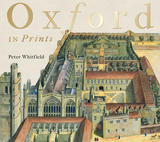 Oxford in Prints: 1675-1900
Peter Whitfield
Bodleian Library Publishing, 2016 For more than three centuries, Oxford has served as a source of inspiration for fine illustrated books and engraved prints. These works hold an important place in the historical record of the city, showing its identity to be deeply rooted in history while also chronicling Oxford’s development through the architecture of its most beautiful college and university buildings.
With Oxford in Prints, Peter Whitfield has assembled a rich selection of more than seventy illustrations and prints that offer a portrait of Oxford before it became the modern city it is today. Seventeenth-century prints by David Loggan show the medieval origins of Oxford University already overlaid by Tudor and Stuart buildings. Eighteenth-century editions of the Oxford Almanack depict a city dominated by neoclassical ideas. By the nineteenth-century, illustrations in the Almanack had an increasingly romantic feel, with buildings against a natural background of the river, trees, and sky. Each illustration or print is accompanied by an insightful description, including salient historical features.
Oxford in Quotations
Compiled by Violet Moller
Bodleian Library Publishing, 2014 Oxford is one of the world’s great cities—a source of inspiration to generations of poets, novelists, journalists, and commentators who have visited or called it home. Be it praise or colorful invective, everyone, it seems, has something to say about the city and this slender volume—filled with wise, witty, and sometimes scandalous quotes—presents the full range of impressions it has made.
Oxford, “City of Dreaming Spires,” earns high marks from Hillaire Belloc, who writes that “there are few greater temptations on earth than to stay permanently at Oxford . . . and to read all the books in the Bodleian.” But it is also, according to Anthony Trollope, “the most dangerous place to which a young man can be sent.” And none other than Max Beerbohm blames it for making him insufferable.
For fans, foes, and those planning a trip to the city in the hopes of forming an opinion, this collection will be welcomed.
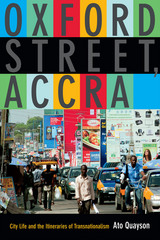 Oxford Street, Accra: City Life and the Itineraries of Transnationalism
Ato Quayson
Duke University Press, 2014 In Oxford Street, Accra, Ato Quayson analyzes the dynamics of Ghana's capital city through a focus on Oxford Street, part of Accra's most vibrant and globalized commercial district. He traces the city's evolution from its settlement in the mid-seventeenth century to the present day. He combines his impressions of the sights, sounds, interactions, and distribution of space with broader dynamics, including the histories of colonial and postcolonial town planning and the marks of transnationalism evident in Accra's salsa scene, gym culture, and commercial billboards. Quayson finds that the various planning systems that have shaped the city—and had their stratifying effects intensified by the IMF-mandated structural adjustment programs of the late 1980s—prepared the way for the early-1990s transformation of a largely residential neighborhood into a kinetic shopping district. With an intense commercialism overlying, or coexisting with, stark economic inequalities, Oxford Street is a microcosm of historical and urban processes that have made Accra the variegated and contradictory metropolis that it is today.
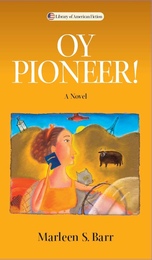 Oy Pioneer!: A Novel
Marleen S. Barr
University of Wisconsin Press, 2003 What would happen if a feminist Jewish wit and scholar invaded David Lodge’s territory? Marleen S. Barr, herself a pioneer in the feminist criticism of science fiction, provides a giddily entertaining answer in this feisty novel. Oy Pioneer! follows professor Sondra Lear as she makes her inimitable way through a world of learning—at times fantastic, at times all too familiar, often hilarious, and always compulsively interesting.
As if Mel Brooks and Erica Jong had joined forces to recreate Sex and the City for the intellectual set, the story is a heady mix of Jewish humor, feminist insight, and academic satire. Lear is a tenured radical and a wildly ambitious intellectual, but is subject nonetheless to the husband-hunting imperatives of her Jewish mother. Her adventures expand narrative parameters according to Barr’s term "genre fission."
Mixing elements of science fiction, fantasy, ethnic comedy, satire, and authentic experience of academic life, Oy Pioneer! is uncommonly fun—a Jewish feminist scholar’s imaginative text boldly going where no academic satire has gone before—and bringing readers along for an exhilarating ride.
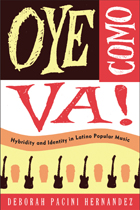 Oye Como Va!: Hybridity and Identity in Latino Popular Music
Deborah Pacini Hernandez
Temple University Press, 2009 Listen Up! When the New York-born Tito Puente composed "Oye Como Va!" in the 1960s, his popular song was called "Latin" even though it was a fusion of Afro-Cuban and New York Latino musical influences. A decade later, Carlos Santana, a Mexican immigrant, blended Puente’s tune with rock and roll, which brought it to the attention of national audiences. Like Puente and Santana, Latino/a musicians have always blended musics from their homelands with other sounds in our multicultural society, challenging ideas of what "Latin" music is or ought to be. Waves of immigrants further complicate the picture as they continue to bring their distinctive musical styles to the U.S.—from merengue and bachata to cumbia and reggaeton. In Oye Como Va!, Deborah Pacini Hernandez traces the trajectories of various U.S. Latino musical forms in a globalizing world, examining how the blending of Latin music reflects Latino/a American lives connecting across nations. Exploring the simultaneously powerful, vexing, and stimulating relationship between hybridity, music, and identity, Oye Como Va! asserts that this potent combination is a signature of the U.S. Latino/a experience.
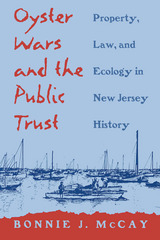 Oyster Wars and the Public Trust: Property, Law, and Ecology in New Jersey History
Bonnie J. McCay
University of Arizona Press, 1998 Who owns tidal waters? Are oyster beds common holdings or private property? Questions first raised in colonial New Jersey helped shape American law by giving rise to the public trust doctrine. Today that concept plays a critical role in public advocacy and environmental law.
Bonnie McCay now puts that doctrine in perspective by tracing the history of attempts to defend common resources against privatization. She tells of conflicts in New Jersey communities over the last two centuries: how fishermen dependent on common-use rights employed poaching, piracy, and test cases to protect their stake in tidal resources, and how oyster planters whose businesses depended on the enclosure of marine commons engineered test cases of their own to seek protection for their claims.
McCay presents some of the most significant cases relating to fishing and waterfront development, describing how the oyster wars were fought on the waters and in the court rooms—and how the public trust doctrine was sometimes reinterpreted to support private interests. She explores the events and people behind the proceedings and addresses the legal, social, and ecological issues these cases represent.
Oyster Wars and the Public Trust is an important study of contested property rights from an anthropological perspective that also addresses significant issues in political ecology, institutional economics, environmental history, and the evolution of law. It contributes to our understanding of how competing claims to resources have evolved in the United States and shows that making nature a commodity remains a moral problem even in a market-driven economy.
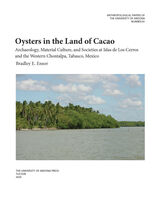 Oysters in the Land of Cacao: Archaeology, Material Culture, and Societies at Islas de Los Cerros and the Western Chontalpa, Tabasco, Mexico
Bradley E. Ensor
University of Arizona Press, 2020 For decades, the Chontalpa region of Tabasco, Mexico, conjured images of the possible origins of the Itzá, who migrated, conquered, or otherwise influenced much of Mesoamerica. In Oysters in the Land of Cacao, archaeologist Bradley E. Ensor provides an important resource for Mesoamerican Gulf Coast archaeology by offering a new and detailed picture of the coastal sites vital to understanding regional interactions and social dynamics.
This book synthesizes data from multiyear investigations at a coastal site complex in Tabasco—Islas de Los Cerros (ILC)—providing the first modern, systematic descriptions and analyses of material culture that challenge preconceptions while enabling new perspectives on cultural developments from the Formative to Late Classic periods through the lens of regional comparisons and contemporary theoretical trends. Ensor introduces a political ecological understanding of the environment and archaeological features, overturns a misconception that the latter were formative shell middens, provides an alternative pottery classification more appropriate for the materials and for contemporary theory, and introduces new approaches for addressing formation processes and settlement history.
Building on the empirical analyses and discussions of problems in Mesoamerican archaeology, this book contributes new approaches to practice and agency perspectives, holistically integrating intra- and interclass agency, kinship strategies, gender and age dynamics, layered cultural identities, landscapes, social memory, and foodways and feasting. Oysters in the Land of Cacao addresses issues important to coastal archaeology within and beyond Mesoamerica. It delivers an overdue regional synthesis and new observations on settlement patterns, elite power, and political economies.
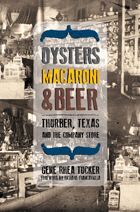 Oysters, Macaroni, and Beer: Thurber, Texas, and the Company Store
Gene Rhea Tucker, with foreword by Richard Francaviglia
Texas Tech University Press, 2012 From 1894 to 1934, a span of forty years that saw its parent company go from coal mining to oil drilling, the Texas Pacific Mercantile and Manufacturing Company operated and managed the various commercial and service enterprises essential to the life and history of Thurber, Texas. Thurber was a company town, wholly owned by the Texas and Pacific Coal Company, and the inhabitants viewed the “company store” with suspicion before and after unionization in 1903, believing it monopolistic and exploitative. But to call the mercantile a monopoly, or a mere contrivance to exploit laborers, paints an incomplete portrait of the company store as it existed in Thurber and elsewhere. With a keen eye for spotting telling detail, Gene Rhea Tucker examines a wealth of company ledgers, interviews, and newspaper accounts, presenting a case study not only of the microcosm of Thurber and TPM&M but of relations between labor and management in industrializing Texas, and a larger story of the complex role of the company store and company town in America.
Oyvind Fahlstrom: The Art of Writing
Sergio Bessa
Northwestern University Press, 2008 Oyvind Fahltstrom: The Art of Writing serves as both an informative and entertaining introduction to the Brazilian-born Swedish poet-artist, one of the mid-twentieth century's most intriguing cultural figures, and as a valuable critical analysis of some of his most important works.
Fahlstrom (1928-76) created a body of work as profoundly political as it is aesthetic, spanning two tumultuous decades in the avant-garde and comprising concrete poetry, manifestos, plays, performance, filmmaking, paintings, multiple prints, sculpture, and installations. Bessa focuses on how Fahlstrom's early experiments with concrete poetry influenced his later works in the visual arts and offers close readings of his seminal work Bord, his painting series Ade-Ledic-Nander, his interactive painting The Planetarium, and his radio play Birds in Sweden.
Ozark Country
Otto Ernest Rayburn
University of Arkansas Press, 2021 Published just days before America’s entry into World War II, Ozark Country is Otto Ernest Rayburn’s love letter to his adopted region. One of several chronicles of the Ozarks that garnered national attention during the Depression and war years, when many Americans craved stories about people and places seemingly untouched by the difficulties of the times, Rayburn’s colorful tour takes readers from the fictional village of Woodville into the backcountry of a region teeming with storytellers, ballad singers, superstitions, and home remedies. Rayburn’s tales—fantastical, fun, and unapologetically romantic—portray a world that had already nearly disappeared by the time they were written. Yet Rayburn’s depiction of the Ozarks resonates with notions of the region that have persisted in the American consciousness ever since.
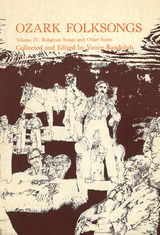 Ozark Folksongs: Volume IV, Religious Songs and Other Items
Vance Randolph
University of Missouri Press, 1980
Originally published in 1949, this comprehensive gathering of folksongs is being reissued after many years out of print. The renewed interest in folklore among the general public as well as the scholarly community has prompted this publication.
The collection comprises four volumes including more than eight hundred songs, indexed by title, by first line, and by contributor and town. Each song is thoroughly annotated. In addition to lyrics, the compiler furnished scores and variant lyrics and titles for each song and listed similarities to other songs along with whatever historical information was available to him.
The songs are presented in four volumes. The fourth volume is an assortment of religious songs, hymns, and revival tunes along with sentimental ballads and journalistic pieces.
Characteristic of the compiler's careful work is the painstaking accuracy with which dialect peculiarities are preserved. Randolph scrupulously avoided correcting pronunciation or adding missing words or forgotten lines. Because, as he explains in his introduction, many of the people who sang for him were reluctant to have their voices recorded, his texts represent the best possible reproduction of this priceless American folk art.
A new introduction by W. K. McNeil, folklorist for the Ozark Folklore Center and book review editor for the Journal of American Folklore, comments on Randolph's importance to the field of American folklore and the significance of this work in particular.
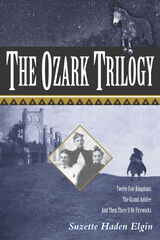 The Ozark Trilogy: Twelve Fair Kingdoms, The Grand Jubilee, And Then There’ll Be Fireworks
Suzette Haden Elgin
University of Arkansas Press, 2000 The Ozark Trilogy (previously published in 1981, Doubleday) is a widely acclaimed fantasy/science fiction story with, as the title suggests, very strong ties to the Ozark region. Twelve Fair Kingdoms, The Grand Jubilee, And Then There’ll Be Fireworks—the books that comprise the trilogy—chronicle life on the planet Ozark and its Confederation of Continents, which are appropriately named Arkansaw, Oklahomah, Mizzurah, Tinaseeh, Kintucky, and Marktwain. However, the story told here involves much more than a mere transplant of Ozark culture and heritage onto a new planet. While this new Ozark culture maintains and even intensifies many of the “real” Ozark traditions and customs (for instance, “Grannys” hold significant, stabilizing social roles and are important sources of wisdom), the planet Ozark combines many new, fantastical elements with traditional ways. Mules on Ozark fly, and the wise “Grannys” also work magic. The protagonist of The Ozark Trilogy, Responsible of Brightwater, appears at the center of Ozark society, a society she must save from evil magic, civil war, and, ultimately, alien invasion. As Responsible travels from continent to continent in an attempt to discover and squelch the evil magic and calm the civil unrest, we are witness to many dangerous and sometimes comical adventures along the way, including a spectacular flying Mule crash and a magic duel with a Granny gone bad. Elgin has created a fantastic world infused with the folk traditions, social and familial hierarchies, and traditional dialect of the Ozarks. While parallels might be drawn between, for example, the break-up of the Confederacy of Continents on planet Ozark and the American Civil War, Elgin comments on aspects of Ozark history and tradition in a non didactic way. The trilogy, with its strong heroine and witty engagement of tradition, is a classic of Ozark literature.
Ozark Vernacular Houses: A Study of Rural Homeplaces in the Arkansas Ozarks, 1830-1930
Jean Sizemore
University of Arkansas Press, 1994 Over 160 photographs, drawings, and maps provide examples of the four traditional Ozark house types and reveal the unity of a distinctive Arkansas culture that bears identity with all hill peoples. Of importance to architects, folklorists, cultural historians, and anyone interested in the Ozarks, this fascinating examination of the Ozark house is a way toward understanding the mind of the inhabitants and their entire way of life.
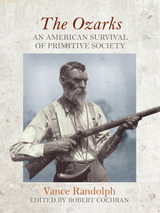 The Ozarks: An American Survival of Primitive Society
Vance Randolph
University of Arkansas Press, 2017 Vance Randolph was perfectly constituted for his role as the chronicler of Ozark folkways. As a self-described “hack writer,” he was as much a figure of the margins as his chosen subjects, even as his essentially romantic identification with the region he first visited as the vacationing child of mainstream parents was encouraged by editors and tempered by his scientific training. In The Ozarks, originally published in 1931, we have Randolph’s first book-length portrait of the people he would spend the next half-century studying. The full range of Randolph’s interests—in language, in hunting and fishing, in folksongs and play parties, in moonshining—is on view in this book that made his name; forever after he was “Mr. Ozark,” the region’s preeminent expert who would, in collection after collection, enlarge and deepen his debut effort. With a new introduction by Robert Cochran, The Ozarks is the second entry in the Chronicles of the Ozarks series, a reprint series that will make available some of the Depression Era’s Ozarks books. An image shaper in its day, a cultural artifact for decades to come, this wonderful book is as entertaining as ever.
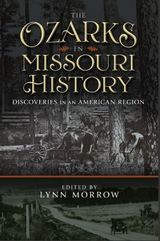 The Ozarks in Missouri History: Discoveries in an American Region
Edited by Lynn Morrow
University of Missouri Press, 2013 Interest in scholarly study of the Ozarks has grown steadily in recent years, and The Ozarks in Missouri History: Discoveries in an American Region will be welcomed by historians and Ozark enthusiasts alike. This lively collection gathers fifteen essays, many of them pioneering efforts in the field, that originally appeared in the Missouri Historical Review, the journal of the State Historical Society. In his introduction, editor Lynn Morrow gives the reader background on the interest in and the study of the Ozarks. The scope of the collection reflects the diversity of the region. Micro-studies by such well-known contributors as John Bradbury, Roger Grant, Gary Kremer, Stephen Limbaugh Sr., and Milton Rafferty explore the history, culture, and geography of this unique region. They trace the evolution of the Ozarks, examine the sometimes-conflicting influences exerted by St. Louis and Kansas City, and consider the sometimes highly charged struggle by federal, state, and local governments to define conservation and the future of Current River.
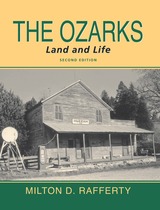 The Ozarks: Land and Life
Milton D. Rafferty
University of Arkansas Press, 2001 The Ozark Mountains reach into Missouri, Arkansas, Oklahoma, and Kansas, forming a region with great natural beauty and a distinctive cultural and historical landscape. This comprehensive volume, a fully updated edition of a beloved classic, reaches into history, anthropology, economics, and geography to explore the complex relationships between the Ozarks' people and land through times of profound change. Drawing on more than thirty years of research, field observations, and interviews, Rafferty examines this subject matter through a range of topics: the settlement patterns and material cultures of Native Americans, French, Scotch-Irish, Germans, Italians, African Americans, Hispanics, and Asians in the region; population growth; the guerrilla warfare and battles of the Civil War; the cultural transformations wrought by railroads, roads, mass media, and modern communication systems; the discovery, development, and decline of the great mining districts; the various forms of agriculture and the felling of the region's vast forests; and the built landscape, from log cabins to Victorian mansions to strip malls. This new edition also explores the new and potent forces which have reshaped the region over the last twenty years: tourism and the growing service industry, suburbanization, rapid population growth and retirement living, and agribusiness. Lavishly illustrated with historic and contemporary photographs, maps, and charts.
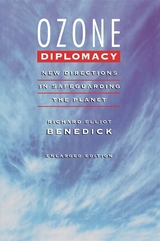 Ozone Diplomacy: New Directions in Safeguarding the Planet, Enlarged Edition
Richard Elliot Benedick
Harvard University Press, 1998 Hailed in the Foreign Service Journal as “a landmark book that should command the attention of every serious student of American diplomacy, international environmental issues, or the art of negotiation,” and cited in Nature for its “worthwhile insights on the harnessing of science and diplomacy,” the first edition of Ozone Diplomacy offered an insider’s view of the politics, economics, science, and diplomacy involved in creating the precedent-setting treaty to protect the Earth: the 1987 Montreal Protocol on Substances That Deplete the Ozone Layer.
The first edition ended with a discussion of the revisions to the protocol in 1990 and offered lessons for global diplomacy regarding the then just-maturing climate change issue. Now Richard Benedick—a principal architect and the chief U.S. negotiator of the historic treaty—expands the ozone story, bringing us to the eve of the tenth anniversary of the Montreal Protocol. He describes subsequent negotiations to deal with unexpected major scientific discoveries and important amendments adding new chemicals and accelerating the phaseout schedules. Implementing the revised treaty has forced the protocol’s signatories to confront complex economic and political problems, including North–South financial and technology transfer issues, black markets for banned CFCs, revisionism, and industry’s willingness and ability to develop new technologies and innovative substitutes. In his final chapter Benedick offers a new analysis applying the lessons of the ozone experience to ongoing climate change negotiations.
Ozone Diplomacy has frequently been cited as the definitive book on the most successful environment treaty, and is essential reading for those concerned about the future of our planet.
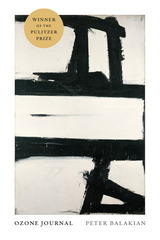 Ozone Journal
Peter Balakian
University of Chicago Press, 2015 WINNER OF THE PULITZER PRIZE
from "Ozone Journal"
Bach’s cantata in B-flat minor in the cassette,
we lounged under the greenhouse-sky, the UVBs hacking
at the acids and oxides and then I could hear the difference
between an oboe and a bassoon
at the river’s edge under cover—
trees breathed in our respiration;
there was something on the other side of the river,
something both of us were itching toward—
radical bonds were broken, history became science.
We were never the same.
The title poem of Peter Balakian's Ozone Journal is a sequence of fifty-four short sections, each a poem in itself, recounting the speaker's memory of excavating the bones of Armenian genocide victims in the Syrian desert with a crew of television journalists in 2009. These memories spark others—the dissolution of his marriage, his life as a young single parent in Manhattan in the nineties, visits and conversations with a cousin dying of AIDS—creating a montage that has the feel of history as lived experience. Bookending this sequence are shorter lyrics that span times and locations, from Nairobi to the Native American villages of New Mexico. In the dynamic, sensual language of these poems, we are reminded that the history of atrocity, trauma, and forgetting is both global and ancient; but we are reminded, too, of the beauty and richness of culture and the resilience of love.
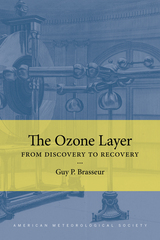 The Ozone Layer: From Discovery to Recovery
Guy P. Brasseur
American Meteorological Society, 2020 From the discovery of ozone in the eighteenth century, through the late twentieth-century international agreements to protect humanity from the destruction of ozone in the stratosphere, Guy P. Brasseur traces the evolution of our scientific knowledge on air quality issues and stratospheric chemistry and dynamics. The history of ozone research is marked by typical examples of the scientific method at work, perfectly illustrating how knowledge progresses. Hypotheses are contested and then eventually accepted or rejected; truths once believed to be universal and permanent can be called into question; and debates and disagreements between scientists are settled by information from laboratory and field experiments. Of course, the scientific method can also lead to new observations—in this case, the discovery of the ozone hole. This finding took researchers by surprise, leading to new investigations and research programs.
This first complete study of ozone research demonstrates the key role fundamental research plays in solving global environmental, climate, and human health problems. More importantly, it shows that the scientific method works. Convincing decision makers of research results that do not correspond to their values, or to the interests of certain business groups, stands to be the highest hurdle in using science to benefit humanity. Students, early-career scientists, and even specialists who do not know much about the history of their field will benefit from this big picture view, offered by a researcher who has played leadership roles in stewarding this science through decades of discovery.
 Ozu’s Anti-Cinema
Yoshida Kiju; Translated by Daisuke Miyao & Kyoko Hirano
University of Michigan Press, 2003 Yoshida starts his award-winning Ozu’s Anti-Cinema with a story about his trip to Ozu’s deathbed. Yoshida writes that a dying Ozu whispered to him twice, as if speaking to himself, “Cinema is drama, not accident.” These cryptic last words troubled Yoshida for decades, and throughout this book he examines Ozu’s films and tries to uncover what Ozu really meant. Ozu’s Anti-Cinema concerns Ozu’s films, but it is also Yoshida’s manifesto on films and filmmaking. In other words, this book is Yoshida’s personal journey into Ozu’s thoughts on filmmaking and, simultaneously, into his own thoughts on the nature of cinema. Every page displays the sensibility of one artist discussing another—this is probably a book that only a filmmaker could write. Within Yoshida’s luminous prose lies a finely tuned, rigorous analysis of Ozu’s films, which have rarely been engaged as closely and personally as here.
|
|

